






Hello, and welcome to latest edition of The Brewers Journal!
Is it just me or does it feel that summer came and went? With a wealth of beer festivals and events expertly navigated and a sleuth of beer releases for the warmer months released, attention has long since turned to the fall and winter months that lie ahead.
As we approach the end of the year, inhouse our attention is on The Brewers Lectures where we aim to give a platform to speakers to inspire change, generate discussion & share brewing expertise.
Join us on October 18th, 2023 as we head out Canada’s Royal City, New Westminster, BC and kick-start the 2023 BC Craft Brewers Conference that takes place October 19th-20th, 2023.
We are also proud to have the returning of the Canadian Brewers Choice Awards (CBCAs). Dubbed as the “mini Oscars” designed to recognize the very best in Canadian brewing, where the best of the best are put in the spotlight for their achievements.
And in this very issue, we profile three breweries that have excellence and achievement as their middle names.
While many breweries are still coming to terms with the impact the COVID-19 pan-

demic had on them and their businesses, The Second Wedge Brewing Co had to contend with the devastating impact an EF-2 tornado had on their Uxbridge facility last year. But thankfully, due to hard work and overwhelming support, they are back on their feet. We caught up with co-founder Joanne Richter to find out more about how they’ve navigated the last 16 months.
We also want to welcome you to Good Neighbour Brewing, a force for good in Winnipeg, Manitoba. Founded by Morgan Wielgosz and Amber Sarraillon, the brewery produces a range of exciting beer styles from Czech Pale Lager to Margarita Gose, and a lot more besides. In this edition, we discuss the brewery’s commitment to innovation, its desire to represent marginalised groups and why Good Neighbour Brewing is the culmination of a career working at breweries across Canada.
And when Marie-Pier Veilleux helped start Montreal’s Brasserie Harricana, she knew what she wanted to do, and how she wanted to do it. In 2023, that means a place you can come for great beer, great beer and a great time - regardless of who you are. You can read more of our interview with Marie-Pier and her colleague Cassiel Lalande in elsewhere in this edition.
In addition, there’s a lot more content besides. I hope you have a great conclusion to the summer and best of luck in all that you do!
Tim Sheahan Editor
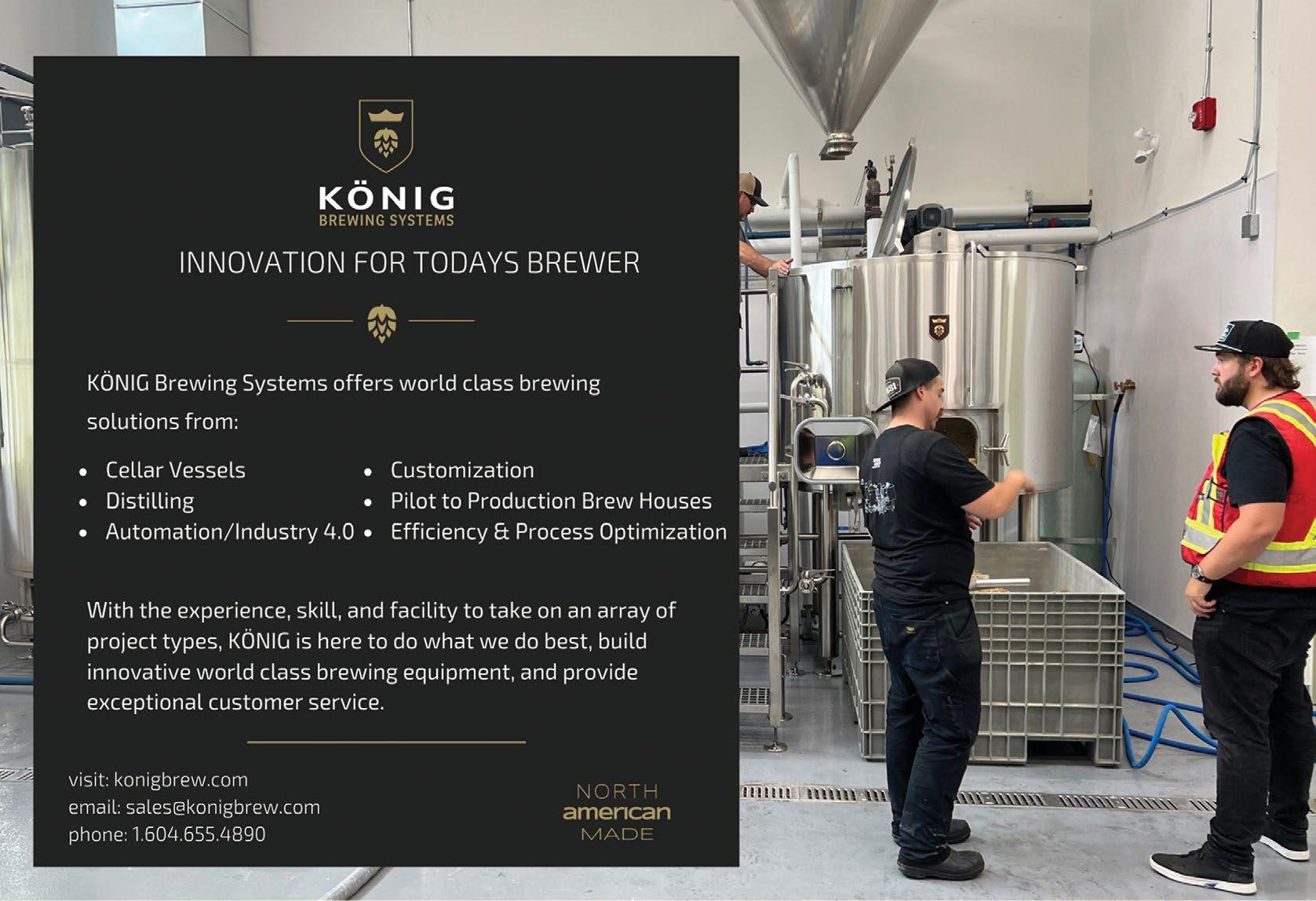


Stories from CrowdfundSuite, the crowd building and crowd finance agency which has raised more than $50 million for its clients.
Comment | Marketing
Mike Kallenberger, a Senior Advisor, marketing insights and strategy at First Key consulting explains how to take steps towards creating more brand evangelists.
Focus | Innovation
An Insider investigation from Flavorsum on innovation ideas to keep beer sales from going flat.
Comment | Beer Babes Family
Rachel Benkowski, Co-Founder of the Beer Babes Family, gives us an in-depth introduction to this Can-American Association.
Returning Home | Second Wedge Brewing Co.
After being devastatingly struck by an EF-2 tornado just last year, Second Wedge Brewing gets back up on its feet in record time through hard work and overwhelming support.
Rod Charles speaks with Manitoulin Island Brewing partner Blair Hagman on what it’s like being a brewery located on the largest freshwater island in the world.
The team at Ultrafilter takes a deep dive into one of key components that make all the difference when brewing: filtration.
Meet the Brewer | Brasserie Harricana
Marie-Pier Veilleux explains what she wanted accomplished when she started Montreal’s Brasserie Harricana, which included being a place you can come for great beer, great food, and a great time – regardless of who you are.
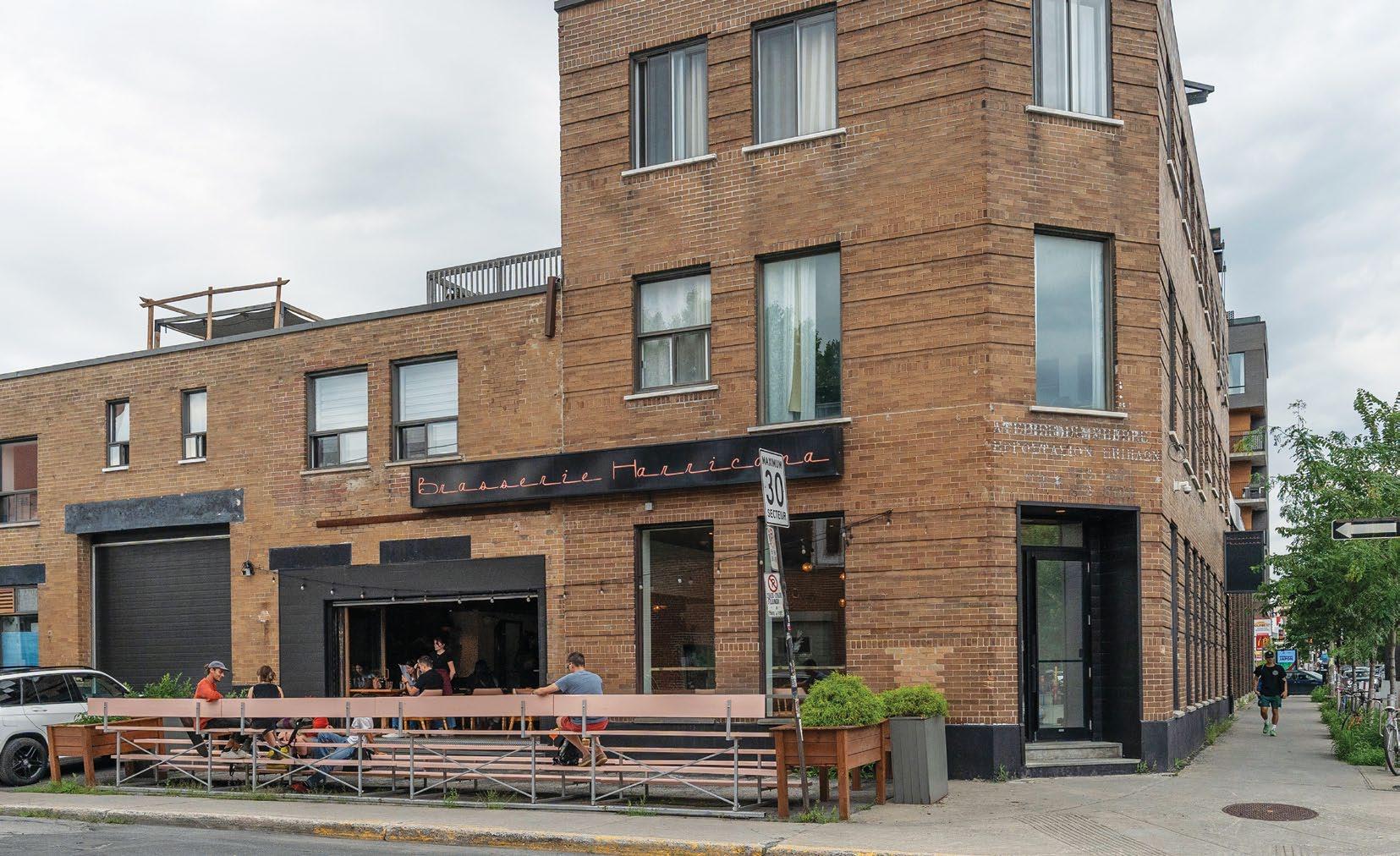
Focus | No and Low Maxim Samure from Brew Culture, goes into details on some distinct and extra challenges involved in getting no-and-low alcohol beers right.
Paul Davies, the Founder of Alehunters Brewery Tours, gives us a lowdown on where to head to enjoy the fantastic beer scene that Barcelona has to offer.

Tim Sheahan Editor tim@brewersjournal.ca +44 (0)1442 780 592
Jakub Mulik Staff photographer
Johnny Leung Canada Partnerships johnny@brewersjournal.ca

Sheena Strauss Homebrew Journal knwl.on.tap@gmail.com
Richard Piotrowski Publisher Richard@brewersjournal.ca
Magdalena Lesiuk Graphic Design GraphMad@gmail.com
CFJ Media
2275 Upper Middle Rd E #101, Oakville, ON L6H 0C3
The Brewers Journal Canada is a quarterly magazine mailed every Spring, Summer, Autumn and Winter. Subscriptions can be purchased for four or eight issues. Prices for single issue subscriptions or back issues can be obtained by emailing: johnny@brewersjournal.ca
CANADA One year: $39
INTERNATIONAL One year: $49
The content of The Brewers Journal Canada is subject to copyright. However, if you would like to obtain copies of an article for marketing purposes high-quality reprints can be supplied to your specification. Please contact the advertising team for full details of this service. The Brewers Journal Canada is printed at Print Buy, 15 - 1253 Silvan Forest Drive, Burlington ON, L7M 0B7
A force for good in Winnipeg, Manitoba, brewery founders Morgan Wielgosz and Amber Sarraillon dive right into the various range of exciting beer styles matched with the vision of creating a brewery that is bigger than just beer – and themselves.
All rights reserved. No part of this publication may be: reproduced or transmitted in any form or by any means, electronic or mechanical, including photocopying, recording or any information storage or retrieval system, without the express prior written consent of the publisher. The Brewers Journal Canada ISSN 2398-6948 is part of Reby Media, 42 Crouchfield, Hemel Hempstead, Herts HP1 1PA. It is published quarterly in Canada by CFJ Media, 2275 Upper Middle Rd E #101, Oakville, ON L6H 0C3, Canada. Subscription records are maintained at CFJ Media, 2275 Upper Middle Rd E #101, Oakville, ON L6H 0C3, Canada. The Brewers Journal accepts no responsibility for the accuracy of statements or opinion given within the Journal that is not the expressly designated opinion of the Journal or its publishers. Those opinions expressed in areas other than editorial comment may not be taken as being the opinion of the Journal or its staff, and the aforementioned accept no responsibility or liability for actions that arise therefrom.




Shaketown Co-founder/CEO Ryan Scholz recalls: “We opened in March of last year, just as we were emerging from the slower winter months.” Recognizing the need to generate consistent revenue during slower periods, Scholz turned to the “Beer for Life” membership model. The idea was simple – provide patrons with a lifetime of free beer - one 20 ounce beverage of their choice every week - in exchange for an upfront investment of $350. This concept of “crowd capital,” where patrons collectively contribute to the brewery’s financial stability, proved to be a game-changer.
the member’s name adding a layer of exclusivity. With meticulous attention to detail, Scholz sought legal counsel to ensure compliance and mitigate any potential issues.
As members redeem their weekly pints, the impact of “Beer for Life” transcends numbers on a balance sheet. Stories emerge, like the elderly gentleman relishing a lifetime of free beer ahead, a member who recently told Scholz his “Beer for Life” membership is his favourite story and parties and friends that gather regularly, united by their shared membership.
THE URBAN CIDERY REVOLUTION: INTRODUCING NATHALY NAIRN OF WINDFALL CIDER
In the evolving landscape of craft beverages, the counter-intuitive concept of “Free Beer (or Cider) for Life” is turning customers into raving fans. But it’s not just about the beverages itself; it’s about fostering community, cultivating relationships, and embracing the power of “crowd capital.” In 2023, two Shipyards Brewery District craft entrepreneurs - Ryan Scholz of Shaketown Brewery and Nathaly Nairn of Windfall Cider - created something more profound than a simple membership.

But Scholz’s innovative spirit didn’t end there. He wanted “Beer for Life” to be more than just a financial transaction; he aimed to build a community building off their clever “Shaketonian of the Month” fictional storytelling. Scholz sold out his 100 memberships available, scored valuable publicity and transformed patrons into loyal brand ambassadors.
In an era where digital interactions often reign supreme, the tactile nature of “Beer for Life” memberships struck a chord. Scholz recognized the value of providing physical cards to members, turning their access to free beer into a tangible experience. Each card is meticulously designed, featuring

Nathaly Nairn, co-owner of Windfall Cider, brought a fresh perspective to the industry. A family business rooted in passion and commitment, Windfall Cider set out to create something unique in Vancouver – the first urban cidery. Nairn and her husband Jeff embarked on a journey to establish a cider haven that seamlessly integrated into the urban landscape.
Nairn understood the importance of “crowd capital” and community-building from the
BRET
IS
DIRECTOR OF CLIENT GROWTH FOR CROWDFUNDSUITE, A CROWDBUILDING AND CROWD FINANCE AGENCY WITH $50M RAISED FOR CLIENTS.
HERE, HE SHARES SOME OF HIS STORIES ON CRAFT BEVERAGE MARKETING INNOVATION AND ALTERNATIVE FINANCE.
start. Windfall Cider’s brand identity was carefully curated to reflect its urban ethos, distinguishing itself from farm-based cidery counterparts across BC. Recognizing the growth of the urban cider category in the US, Nairn aimed to create awareness and establish Windfall Cider in a fresh new way.
For Nairn, building customer awareness proved to be a challenging yet invigorating journey. In a crowded market, standing out against larger cider companies required a strategic approach. Instead of competing directly, Windfall Cider positioned itself as a complementary offering within the Ship yards District, becoming an anchor of growth.

Nairn drew inspiration from the success of a Vancouver brewery’s execution of the life time offer. “Cider for Life” was born. The con cept was simple – an exclusive membership that granted patrons a lifetime of free cider and a chance to become brand ambassadors.
By offering an exclusive membership to a select group of cider enthusiasts, Wind fall Cider not only generated immediate cash flow but also gained valuable insights into its most loyal customers, or as Nairn anointed them “our 100 most militant fans.”
The response was overwhelming. Nairn recalls the flood of interest she received, with inbox inquiries pouring in. Within a few short weeks, Windfall Cider sold out 102 memberships, each offering 12 ciders per year. Beyond the financial benefits, Nairn’s initiative successfully brought to gether a group of cider aficionados who now hold a physical card with their name, embodying their role as lifelong patrons.
The journey of Ryan Scholz and Nathaly Nairn exemplifies the potential of “crowd capital” in fostering community, building relationships, and ensuring a lasting impact on the industry. While crowdfunding is the best known crowd strategy, lifetime memberships offer similar benefits albeit smaller rounds of capital injection.
As we raise our glasses to a future defined by innovation and community, the concept of “Beer for Life” and “Cider for Life” stands as a testament to the enduring spirit of craft beverage enthusiasts and the breweries and cideries that fuel their love for exceptional libations.
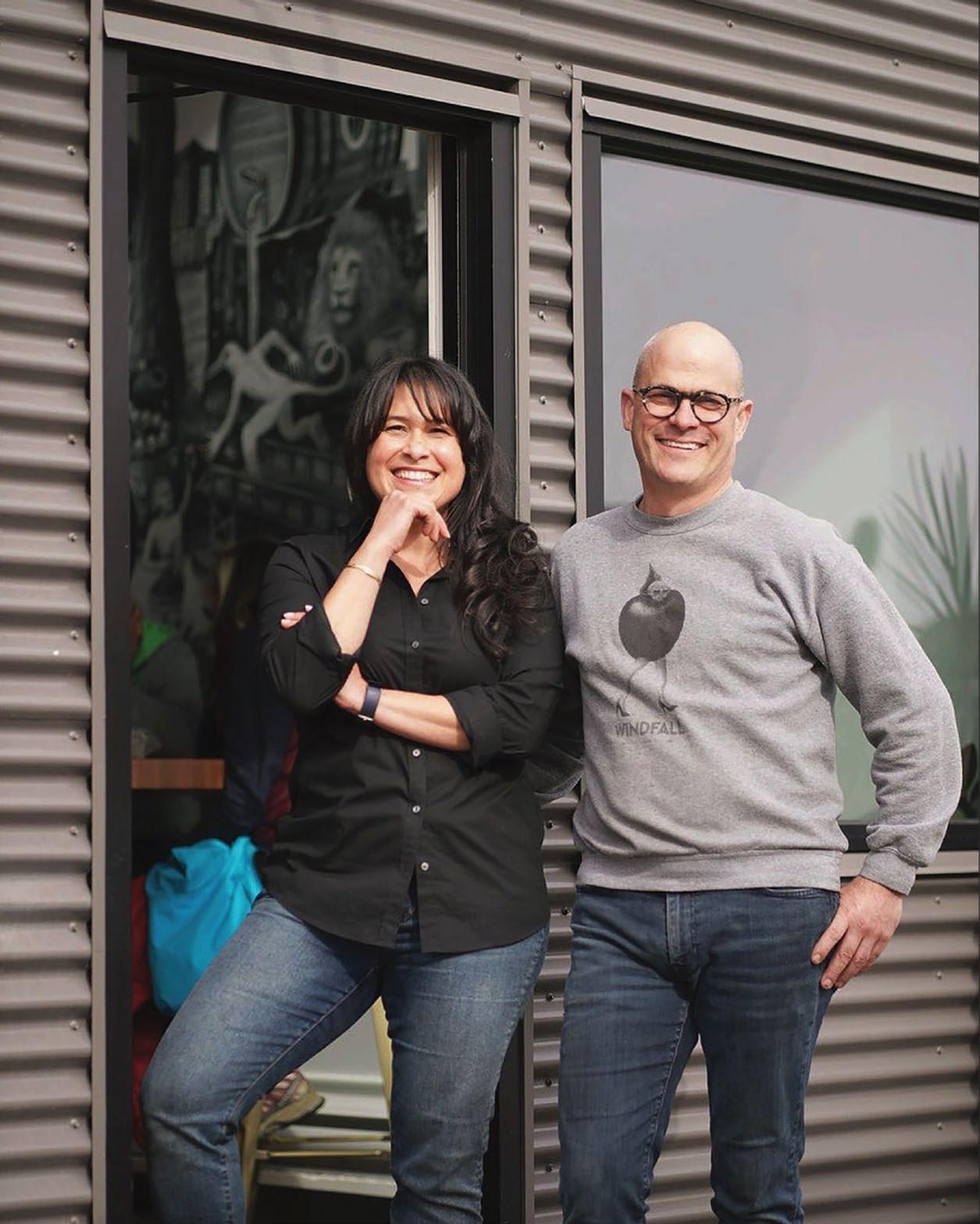



HOW
Yet it’s a general rule of marketing that the consumer target as described in the brand’s strategy statement should be tightly focused. In fact, while it may seem like an oxymoron, it’s true: the more narrowly you define your consumer target, the more successful your brand is likely to be.
one might rightly ask: how did that growth begin in the first place? Was there literally a “first drinker” of the brand, who plucked the first six-pack of the then-brand-new beer off the shelf moments after it arrived at the store – and then went on to influence the first round of new drinkers, who themselves went on to influence others in an ongoing process?
IF
The reason for the disconnect between theory and practice, it seems, stems from several commonplace misunderstandings, not only in terms of how brands grow, but in terms of the role of the defined consumer target in that growth.
MIKE
When asked to define their consumer target, more than one brewer has replied with a description that casts a very wide net – maybe not quite as wide as the above, but still pretty expansive. The intent is seemingly to avoid too much specificity. Many brewers, large and small, feel it’s good strategy not to limit the group of people who will drink their brand.
To oversimplify (but not by too much), most beer brands grow by word of mouth, or social influence. That typically includes many big brands that also rely on advertising. Advertising can reinforce brand usage behavior, but exposure to an ad is less likely to be the impetus for a new drinker to try the brand than is social influence, i.e., current drinkers spreading the word to other drinkers: through overt and sometimes enthusiastic recommendations, by the branded merchandise they wear (along with the implied endorsement), or even by being observed drinking the beer by strangers looking for any kind of helpful cue in a bar with a crowded menu.
But the role of social influence goes beyond a one-time selection on a given occasion, People often adopt brands that become part of their regular buying habits, and this, too, is often driven by the influence of other people. In one consumer survey, beer drinkers were asked their reasons for adopting a brand of regularly-consumed beer in the first place.
(They were asked to choose from an extensive list of possible reasons.) Overwhelmingly, the responses reflected social influence: 70% chose People I know drank it; 43% said A friend recommended it; 34% chose It was an “in” brand.
So if person-to-person influence is driving a brand’s growth in a given month,
While the “first drinker” is essentially mythical, the fact is that the whole social diffusion model requires two types of drinkers: the majority of the brand’s drinkers, who choose it because of the influence of others; and a smaller core of drinkers who in essence jump-start that process because they’re personally drawn by the brand proposition itself: its image, personality, and values. (Of course, this is somewhat oversimplified for the sake of discussion.)
This latter group is (or should be) the brand’s consumer target – those for whom all brand communication is designed, because they are (or will become)
People often adopt brands that become part of their regular buying habits, and this, too, is often driven by the influence of other people,”
Mike Kallenberger, First Key
the brand’s evangelists. Brand evangelists are people who relate so strongly to the brand that their enthusiasm will rub off on others, whether or not those others fully understand or embrace the entire brand proposition. And in order to create that kind of evangelism, the brand strategy should offer a pretty specific description of the target consumer – not necessarily in terms of demographics, but in terms of the attitudes and motivations of those consumers.
Thus, it’s typically better to have a relatively small pool of “brand evangelists” than a larger pool of people who only feel “pretty good” about the brand, but not good enough to bother recommending it. Yet the latter situation is often what results when the consumer target is defined broadly.
Note that at least some of the people who start drinking the brand because of social influence will be enthusiastic enough to make recommendations themselves. They may or may not internalize the brand proposition to any significant degree; their enthusiasm is more a result of ongoing experience with the brand and its associations with good times.

This last point has interesting implications for consumer surveys of brand imagery among drinkers. If such a study only chronicles the results across the entire survey sample, the findings will likely mix apples and oranges. Some fre-
quent drinkers may well be able to play back elements of the brand proposition in encouraging detail, while other equally frequent drinkers will report a positive but not clearly-defined image.
The former group, clearly, represents the brand evangelists, while the latter may well be those who came to the brand through social influence. And so when the image among all frequent drinkers is tabulated, the latter group “waters down” the apparent image of the brand. A brewery may be able to learn a lot by categorizing each survey respondent and breaking out the results by evangelists versus other frequent drinkers.
More than a few successful brands will actually give their consumer target a name, like “Nick” or “Lydia,” and sketch out a portrait of that person. What is their life like? What do they do for a living? What do they do for fun, or to relax? What are their hopes, dreams, and fears – but, more pragmatically, what motivates them to get out of bed each morning? How does beer drinking fit into their daily life? What sort of emotional transition are they seeking to make when they drink beer.
No one real-world drinker will match every detail of the fictional Nick or Lydia. But filtering all ideas for brand communication through the lens of “How will Nick feel about this?” or “Why is this right for Lydia?” helps keep the brand relent-
lessly focused. This not only helps beer drinkers feel they know what the brand stands for, it gives them something to talk about when recommending the brand. And that’s the first step toward creating more brand evangelists.
It’s typically better to have a relatively small pool of “brand evangelists” than a larger pool of people who only feel “pretty good” about the brand,” Mike Kallenberger, First Key
Is beer recession-proof? Is North America IN a recession? And how can brands keep beer sales from going flat through 2023 and 2024? Market dynamics and beer buyers’ behaviors may seem enigmatic or in need of an Economics degree to understand. The team at FlavorSum shines a light on the current economic conditions and offers producers several innovation pathways to build their brands. So, pour a cold one into your favorite Willi Becher, and relax as you discover ideas that may inspire your next brew.
Most economic assessments from reputable sources like Fortune, Forbes, and Bloomberg agree that North America isn’t experiencing a recession – yet. The financial indicators experts track, including inflation, interest rates, consumer confidence, and spending, suggest that the US and Canada are leaning toward a shortterm economic decline.
Inflation, the rate at which prices rise, remains above North America’s 2.0% annual target. The rates are softening, however, hitting 3.4% for Canada in May, down from 4.4% in April. The American market also saw improvement, with the May inflation rate at 4.1%, a drop from April’s 4.9%.
Banks are raising interest rates, the price you pay to borrow money for loans or credit cards, as a tactic to control inflation. Economic theory
suggests increasing interest rates should reduce demand for goods and services. Interest rates in the US and Canada are hovering around 5.0%, a significant uptick in the last year. Despite higher prices and interest rates, consumer confidence or sentiment, a measure of North American’s perceptions about the economy’s strength, is on the upswing. More than two-thirds of Americans and
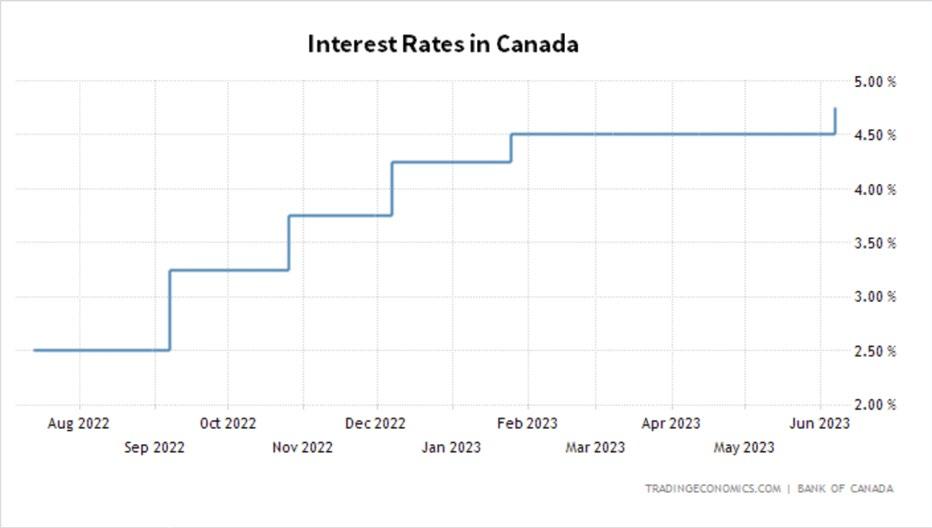

over half of Canadians felt positive about the economy’s future in June, an improvement compared to May.
While Americans may be optimistic about tomorrow, they’re cautious about spending today. The US Commerce Department reports spending on goods typically bought with credit dropped 0.5% in May. Vehicle purchases fell a whopping 23.3%, with
spending on fuel and other energy sources tumbling 23.4%.
According to a GDP report, Canadians surprisingly increased spending in the first quarter of 2023 by almost 6%. But the growth came at the expense of household savings rates which dropped to 3%, and credit card balances which grew 14.5%. Forecasts anticipate flat spending in the Canadian market for the remainder of 2023.

The effects of economic shakiness are manifesting for beer producers in higher prices for ingredients and packaging. Beer Canada reports barley prices increased 60%, packaging costs rose 40%, and freight expenses doubled in the last year.
Some beer brands are passing a portion of the higher cost of goods through to consumers. Retail prices reported by research firm Mintel show the average price per liter is up 3.7% in the US in the last year; estimates for Canadian retail prices show a slight dip.
Mintel also tracks average pricing per pint for new beer launches. Data shows US brand intros are priced 25% higher than last year. And the higher shelf prices don’t reflect the mix since brands put fewer seasonal or premium beers on the shelves. Beers introduced in Canada in 2023 are about 7% lower in price than 2022 innovations.


Industry reports suggest price increases are more significant than reflected in the Mintel data. Beer Canada anticipates prices will go up 10% in 2023, and the US Bureau of Labor Statistics reports beer prices are 6.1% above last year through May. Even with higher prices, beer remains the alcoholic beverage of choice in Canada, representing 35% of the market value. In the US, beer accounts for 41.9% of dollars, taking second place to spirits which hold a 42.1% share.
But the price raises are contributing to the slowdown in North American beer purchases, suggesting the malt favorite is reaching the tipping point of recession resiliency. Volume dropped -3% in the US in 2022, with sales in Canada declining at a similar rate (-2.8%).

Craft beers are a bright spot, holding onto volume in the US in the last year and grabbing 13.2% of the beer market as major brands lose ground. Canadian craft brewers also see a higher market share, generating 10% of 2022 sales.
Beyond price points, buying behaviors are negatively affecting traditional beer sales, led by the following:
The growth of low-ABV seltzers and spirit-based RTDs
• Hard seltzers accounted for 3% of US alcoholic beverage sales in the last year, according to IWSR (International Wine & Spirit Research), and may experience a 3X share gain by 2026. Statista estimates a less than 1% share for seltzers in Canada but calculates volume is growing at more than 40% annually through 2027.
Mintel reports that more than onethird of RTDs launched in North America last year had a wine or spirit base, more than doubling the share of new product development in the past 4 years. ReportLinker estimates RTD cocktail sales will grow almost 9% annually through 2028.
A cultural shift toward less alcohol consumption
• Research firm IBISWorld suggests Canada’s increasingly health-conscious, aging, and slower-growing population is driving the reduced use of alcohol and beer consumption specifically. The recent uptick in drinking reflects a shift to ciders and wine.

• The US Department of Health also reports a decline in per capita alcohol consumption over the past decades driven by less beer drinking. And a wine industry survey indicates 28% of US adults consider themselves ‘abstainers’ in 2023, a 4-point gain since 2017. In total, Americans imbibe about 7.5 liters of alcohol per capita annually.


The rise in non-alcoholic cocktail, wine, and beer options for drinkers interested in consuming less alcohol
The IWSR estimates non-alcoholic beverage volume sales in Canada will increase by +35% annually through 2025. And US beer and wine producers of no-alc beverages saw more than 20% growth in 2022, with no-alc cocktails up 10% and no-alc spirits gaining 88%. The market remains small but is attracting buzz for offering more exciting and complex tastes to those seeking more than a soda and a healthier alternative to alcohol.
Although the pressures on beer brands seem daunting, producers can continue to connect with drinkers through several types of innovation.
A 2023 report from Innova about new, niche and not-for-long products reveals global limited releases represent about 20% of alcoholic beverage launches in the last year. Alcoholic beverages rank
#2 after confections for LTOs. Mintel data shows North American beer LTOs accounted for 13% of new products in the 52 weeks ending May 2023, down from 16% in 2022. Brands can benefit from reinvesting in limited release beers:
Limited editions generate incremental sales: 41% of North Americans say LTOs will likely lead to an impulse purchase, with GenZ and Millennials more eager to buy.
One in 10 alcoholic beverage buyers looked for more LTOs in the past year.
LTOs encourage experimentation and, importantly, enable producers to do a short run of an item that may become part of the everyday assortment.
While many North American beer LTOs showcased styles, several limited releases included flavors ranging from warm browns like mocha and cocoa to fruits and fruit combinations.
Finding the right flavor for your limited edition starts with understanding buyers’ expectations about your brand. Can you push into a Sugar Cookie LTO, or would your buyers be more likely to respond to a more familiar profile like cocoa and spice?
Defining your brand guardrails and collaborating with your ingredient suppliers about trends will improve the likelihood of success for your next limited release.
Creating connections with beer drinkers and getting them to buy is a more
straightforward process when you align with recognizable flavors and favorite styles.
North American beer brands are increasingly targeting IPAs, the leading style launched in the last year. Non-alcoholic beers jumped to the #3 position for new product activity, followed by sours and stouts, which saw double-digit gains in introductions. Lagers, Belgians, and Bocks had less activity in the past 52 weeks.
Mintel’s Global New Products Database reports that about 1 in 3 North American

beers introduced in the last year called out flavor, a level comparable to 2022. Topping the leaderboard are popular flavors: grapefruit, peach, and pumpkin (a seasonal item). Watermelon and tropical flavor launches increased in the latest 52 weeks, along with Berry, Blueberry, and non-specific Fruit profiles. Lime & Sea Salt, Plum, and Tropical Pineapple are new entries in 2023.

North Americans’ interest in health and wellness is one factor leading to less consumption of alcoholic beverages, including beer. A Mintel survey revealed that 6 in 10 US drinkers agree that cutting back on alcohol is a quick way to improve well-being.
Beer brands can address health concerns by calling out existing benefits on packs or developing products with health positionings. About one-third of North American beers introduced in the last 52 weeks had health-related claims. Producers are becoming more focused on innovations free from artificiality, including additives, preservatives, and colors. Mintel reports that organic and all-natural claims also increased in the past year.

Formulating to meet label claim goals should consider brand guardrails and budgetary constraints. For example, if making an all-natural claim is acceptable to current buyers and offers the opportunity to attract new buyers, then investing in appropriate ingredients may be worthwhile.
Hard seltzers offer alcoholic beverage drinkers a lower ABV, lower calorie, lower sugar beverage aligned with health and wellness goals. The segment also delivers desired (and permissible) taste excitement by incorporating citrus flavors that carry a health halo.
Like most beverages, flavor drives the alcoholic beverage purchase decision. Citrus flavors link to easy drinking and refreshment for a sizable group of seltzer drinkers. Notably, Mintel reports that 30% of US drinkers aged 2234 agree fruit flavors are a ‘healthier’ choice in alcohol.

Few North American beer launches include citrus, and the flavor family represents an opportunity for brands to regain some share lost to seltzers. Incorporating familiar citrus tastes will broaden appeal, but limited editions could highlight emerging profiles like clementine or Key Lime. Using citrus blends or mentioning provenances like Meyer Lemon or Red Grapefruit could also generate interest.

Note: Prevalence refers to the raw count of beer launches over 10+ years with heavier weight in recent years. The higher the prevalence, the more products on the shelf with the flavor. Growth momentum reflects 5-year trends, with recent years weighted more heavily. The higher the growth momentum, the more confidence that the trend will continue.
A brand’s story can help establish emotional connections that transcend price. Mintel reports that over half of US alcoholic beverage drinkers link their image with their chosen brand.

A global Price Waterhouse Cooper (PWC) survey suggests sustainability may represent a tangible innovation pathway for beer brands. Results show that:
78% of people agree sustainability is important
55% are willing to pay more for an eco-friendly brand
Importantly, more than 80% state that poor environmental practices will alienate them from a brand
Currently, producers highlighting beer sustainability efforts rely on packaging for the primary message. Over twothirds of North American launches in the last year called out recyclable or environmentally friendly containers. While pausing sustainability efforts to protect margins is tempting during economic uncertainty, brands may need to stay the course, especially if the current positioning emphasizes green initiatives.
For producers exploring ways to expand their sustainability story, consider areas important to brand buyers. Water conser-
vation is becoming top-of-mind for many people. The US Environmental Protection Agency (EPA) anticipates at least 40 states will face water shortages by 2024. With most beers including at least 80% water in addition to hops, barley, yeast, and malt, sharing commitments to water conservation could compel people to buy your brand.
Similarly, highlighting your brand’s water source could enhance taste perceptions. Mintel reports that two-thirds (66%) of Canadian beer drinkers are willing to pay more for higher-quality beer.
Keeping track of product development trends can help you craft an effective growth strategy for your beer brand. FlavorSum prepares quarterly reports about trends in the North American alcoholic beverage category; you can download the latest issue here. To get additional reports and news about relevant market and consumer trends delivered directly to your inbox, subscribe to FlavorSum Discover!

WHEN MARIE-PIER VEILLEUX HELPED START MONTREAL’S BRASSERIE HARRICANA, SHE KNEW WHAT SHE WANTED TO DO, AND HOW SHE WANTED TO DO IT. IN 2023, THAT MEANS A PLACE YOU CAN COME FOR GREAT BEER, GREAT FOOD AND A GREAT TIMEREGARDLESS OF WHO YOU ARE.

“It’s going the way we want it to. We’re moving, we’re growing, and we’re pushing the angles that we want to push. We’re not being pushed by others. It’s a good place to be.”
When it comes to Montreal-based Brasserie Harricana, there’s a sense of resoluteness, of assurance and confidence in their abilities. And why not? The business, founded in 2015, is one that continues to let others do the talking for it. It offers a hospitable environment, excellent beers - some 44 on tap no less - great food and the knowledge that you’re buying into a business with the community at its heart.
Brasserie Harricana was founded by Marie-Pier Veilleux and Cynthia Santamaria. Located in a spot that borders Montreal’s Little Italy and Mile-Ex, its namesake is a river that is also one of the longest waterways in Canada.


But the Brasserie Harricana name is not a new one, either. Part restaurant, part bar, and part brewery - though very much a brewery! - it has something for all. The
original Brasserie Harricana was founded by Marie-Pier’s parents Danielle and XXX. Opening in Amos, Abititbi back in 1975, the establishment was brave and unwavering. Despite it being in the somewhat recent past, their venue was one of the first in the whole of Quebec to welcome women.
“The beauty about what I wanted to build, and I think we’ve reaped what we sow is that we’re a really inclusive place. That comes down to mixed gender, mixed age, mixed background coming in at all times,” says Veilleux.
“So you have visitors, you have locals and you have people doing meetings in suits alongside joggers. I think we’re able to touch very different type of people, and make them comfortable in our space whether they’re connected to Quebec or otherwise.”
Veilleux adds: “We’re lucky to have a very large demographic of people. And that’s exactly what we wanted. Based on the Brasserie Harricana my parents built - it was exactly that. It was a small place where everyone in the city wins, no matter or your social class. I think and hope that we’re doing that.”
Much of that progressive outlook informs the attitudes imbued into Brasserie Harricana’s modern namesake. Like those that paved the wave before them, Marie-Pier Veilleux and her team are guided by the desire to welcome, and to cater for. And if you’re in the mood for a fantastic beer, you’re in luck because there’s lots of them. From Pilsner, to Schwarzbier, Black Cherry IPA to Lime and Pepper Gose or Orange Stout to a Saffron and Pomegranate sour, they have you covered.
If the last few years have taught us anything, it’s to not take anything for granted. But as the brewery calmly approaches the significant landmark of 10 years, Veilleux says they are in a “good moment”.
“We have been waiting to pass that threshold. Only a minute ago it seems like we were reaching the five-year milestone,” she gleams.
Very much a team operation, Veilleux as president works with a group that includes Andrée McKenzie as sales and marketing director, Cassiel Lalande as plant and distribution director, Francis Richer who is brewing director, Charlotte Tiffault as restaurant director and head brewer Antonin Jarvis.
“We always aim to forge our own path and have faith in our own beliefs,” says Lalande. “Marie-Pier Is the head of what we do, it’s her strength. In beer she follows her own direction. You either like it or you don’t… but most like it.” For instance, the brewery’s foray into the world of canning was their Bohemian Pilsner some seven years ago, a style that “wasn’t that popular back then” she recalls. But so be it. It worked well and it has since become a huge hit.
At Brasserie Harricana, if you want wine, it’s not the place for you. There’s some locally-made hard alcohol but the main focus is beer. For those that want wine, they’ll be offered a beer that the consumer might be interested in.
“As a wine-lover, you won’t necessarily like a Pilsner off the bat,” says Veilleux. “So that’s why we’ll look to our barrel-ageing programme to find a beer that fits the flavour-profile of a wine.”
Lalande adds: “The best situation is where we can start that dialogue. If someone says they don’t like beer then I say ok let’s have a conversation and I promise you we’ll find something that will change your perspective on beer. And I think we have helped change that view of many of our clientele when it comes to the expectation of what beer is.”
Which is, perhaps, unsurprising with that incredible range on offer. “I guess everything is about balance. Whatever we do, regardless of flavour, ABV or otherwise, there should be a balance,” explains Veilleux.
Now the head of a revered business, Veilleux spent some of her earlier years studying politics and economics. She was also a passionate basketball player, too. But the restauranteur background from her upbringing stuck with her. The Quebec comfort, food combined with the enthused patrons of Amos enjoying a rare taste of draught beer, stuck with her.
“I grew up in that space. I liked the inclusiveness that it didn’t matter who you were at Brasserie Harricana. But I felt that Montreal didn’t always feel the same way. If you weren’t part of the demographic they were looking for, you’d know that was the case,” she recalls. “I knew I wanted to create the former. Somewhere people were comfortable. So we started with that same premise. We even opened with and use the same furniture!”
You can use that furniture to relax in while enjoy one of many beers, in addition to the other hospitality on offer, too. “We looked at the food offering my parents had and decided to modernise it a little,” says Veilleux. “But central to everything was always

making what we sell in-house. It’s part of the reason we don’t offer wine. I can’t offer that guarantee. And also we can keep the price point at the level we want when doing most things here in Montreal.”
Brasserie Harricana opened without an IPA and without the option to order a beer in pint format, instead opting for eight ounce glasses. “Early on people would be yelling at me and leaving,” laughs Veilleux. “I was thinking what have I done? But we stayed true and people would soon come around to us.” They still do, alongside the relevant temperature and gas level, too.
With the global pandemic, countless breweries and business in wider hospitality were affected. Brasserie Harricana being no exception. As a brewery that had focused on purely catering for its restaurant trade it took a different approach and looked further afield thanks to the ability to can its beers via a mobile canning service. And they’ve never looked back.
“We previously only had the one location. But the pandemic involved us reaching other customers and other venues,” recalls Lalande. “So when restrictions relaxed, we had decisions to make.”
A commitment to their new markets would manifest itself in opening up a new produc-
tion facility in the same neighbourhood as the brasserie. “It’s bigger, drastically bigger,” says Lalande. “But that’s still not that big compared to some places!” The new kit is 10bbl but with the ability to fill double-sized fermenters compared to the single-sized they operate at the restaurant.
“It was important to build a small-big brewery so we could keep the versatility and ability to do smaller batches or deep dive into bigger volumes, too,” says Veilleux. “The overriding message is that the beer is exciting, it’s stable, it’s what you expect from us - regardless of where we brew it.”

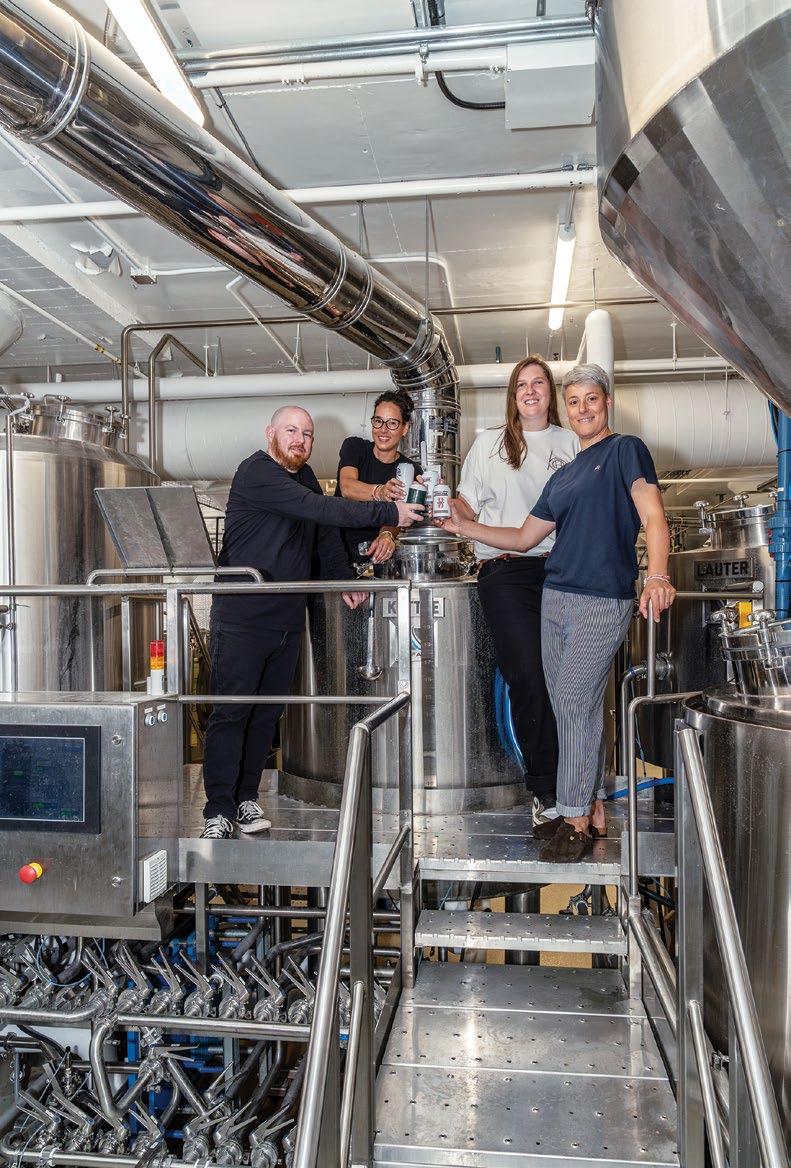
“We have our regulars, and they can put it on their menu. They can be reassured that they know its consistent. For us quality matters at every single part of the journey. That never changes.”
And that is something underpinned by perseverance and attention to detail - in all aspects of the business. “We are in the same boat, and on the same team,” says Lalande. “We’ve made our own club, which is awesome. And we wouldn’t change anything about it.”
Marie-Pier Veilleux concludes: “We are what we are. We stay true to ourselves and won’t shift. We stick to our guns. We always have and always will.”
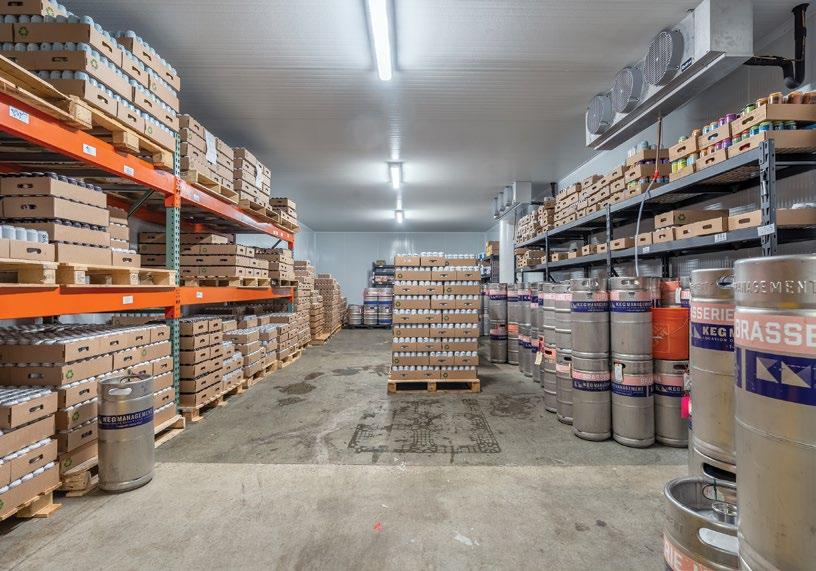






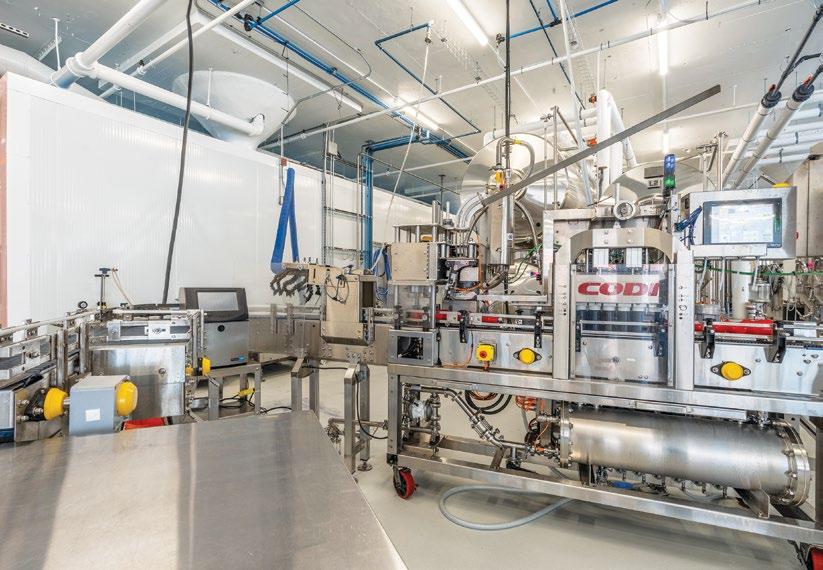

FRESH FROM A VISIT TO THE COSMOPOLITAN CAPITAL OF SPAIN’S CATALONIA REGION
PAUL DAVIES, THE FOUNDER OF ALEHUNTERS BREWERY TOURS, GIVES US THE LOWDOWN ON WHERE TO HEAD TO ENJOY THE FANTASTIC BEER SCENE THAT BARCELONA HAS TO OFFER.

Or should that be ‘Esbossos d’Espanya’ en Catala? Anyway, it’s hard not to love the city of Barcelona. All that Gaudi for a start – La Pedrera, Casa Batlló, Casa Vicens and the breathtaking craftmanship of the Sagrada Familia. And it goes on, with other unique modernist buildings by Cadafalch and Montaner, among others.
For quieter moments the verdant parks of Güell, Ciutadella and Laberint d’Horta offer respite from the teeming crowds of tourists.
Relaxing but never dull, the beaches around Barceloneta also give ample opportunities for a gentle paseo, as long as you keep out of the way of skaters, scooters and bikers.
Then there are the differing personalities of the diverse neighbourhoods –the winding lanes of Barri Góthic, broad majestic avenues of Eixample, pintxos and cool in Poble Sec, arty and trendy El Raval.
Then there’s Gràcia. A warren of narrow streets, numerous plazas swarming with children, crafts of all description, a focus on sustainability, politically-led demonstrations and presentations, human towers (castellers), hip and trendy… it has everything.
Separated from the city until 1897, Gràcia has retained its identity and diversity and wears its Catalan heart on its sleeve.
It sometimes feels like a completely different place to the rest of Barcelona and we fell in love with the region on a visit many years ago.
We decided to make a base here for the month of May in a lovely casita a couple of steps from Plaça del Diamant. So much to see and do our aim was to live like a local and really get under the skin of the city.
To find our favourite local bar, where the best churros are made, new innovative tapas offerings and broaden our appreciation of vermút. Perfect.
But while we were at it I took the opportunity to explore the burgeoning craft beer scene there. Here’s what I found.
You have to go back 30 years to trace the beginnings of the craft beer scene in Spain. This is when Liverpudlian Steve Huxley founded the Barcelona Brewing Company in Grácia.
Known as the father of craft beer in Spain, Steve also founded his beer academy at Cervecería Jazz in Poble Sec.
Unfortunately, Steve passed away in 2015 and in honour of his pioneering
work the Steve Huxley Award has been given to the most pioneering and inspiring individual in the world of Spanish craft beer at the annual Barcelona Beer Festival.
Many cool and crafty bars opened at the same time and some are still pouring great beer, but the current scene really got established during the last decade.
I’ve grouped the bars and taprooms into neighbourhoods where there is a concentration of sites and added in some outliers separately.
Wedged in between Montjuïc and Sant Antoni Poble Sec earned its ‘dry town’ name thanks to not having a water fountain installed until the 19th century.
It is bounded by Avenguda del Parallel which used to house many theatres, music halls and more ‘unsavoury’ establishments which have now faded into an almost century-long obscurity. Nowadays the area is host to a multi-cultural population which is reflected in its bars and restaurants.
The pedestrian Carrer del Blai contains the greatest number of pintxos bars in the city and is worth a bit of bar-hopping. Nearby Cerveseria Jazz was founded in 1992 by Alex Camacho.
He was a founder of the Humulus Lupulus association, which explored home brewing, appreciated beer from other countries and wanted to create a craft beer culture within Catalunya. Here Alex will serve you perfectly poured pints from Catalunya and around the world.
Across the street is Brew Pub le Sec founded by Anna Cufi and Bernat Diego in 2015. In what looks like the world’s smallest brewery, with the production kit perched on a small mezzanine above the bar, they pour some of the best craft beer in the city along with a number of guest beers. They regularly host events but the annual birthday party on 1st May is the one not to be missed.
All the beers that I tried were excellent –Pale Ale, Fruit Sour and Stout (Manic Stout Preachers – I love this!).
If you head up past the pintxos bars of Carrer de Blai you will be going in the direction of Abirradero.
Founded in 2015 in the 100-year-old iconic Abrevadero restaurant by Lluis Sanchez and Daniel Fermun, Abirradero houses a taproom and restaurant with outside seating.
Next door is the brewery where they also help train budding craft brewers in their Instituto de la Cervesa Artesana.
There are many rooms large enough for private celebrations and regular beer festivals and wine tastings. I had a really good Helles and an IPA but the standout was their Saison produced for a local hotel.
A skip across Avenguda del Paral-lel is Barna Brew, founded in 2017 by Alex Lazarowicz and Dimi Tsaousis, who first met in London and later in Brussels when they decided to start a brewery in Barcelona.
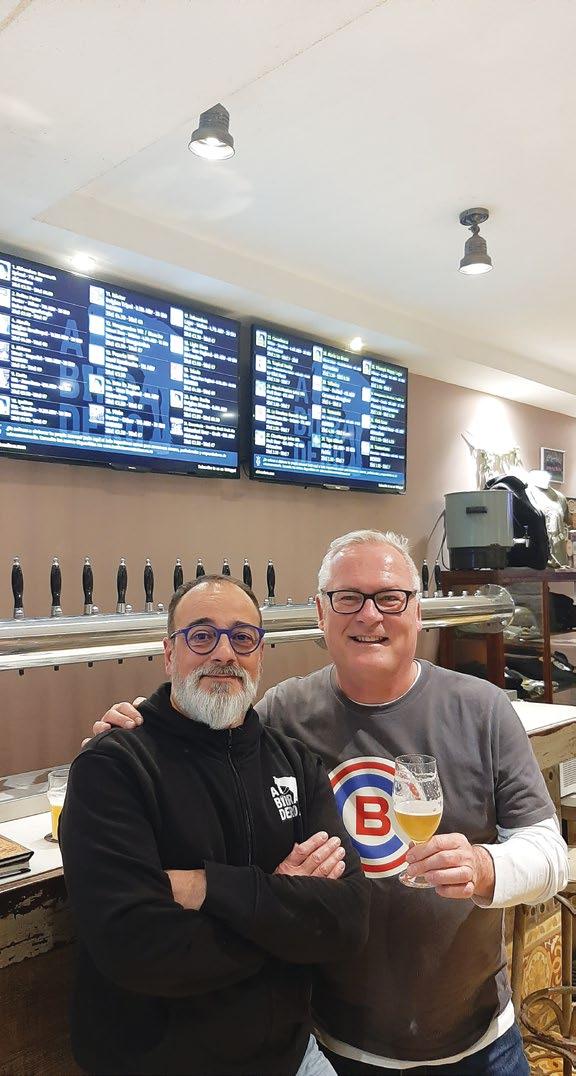
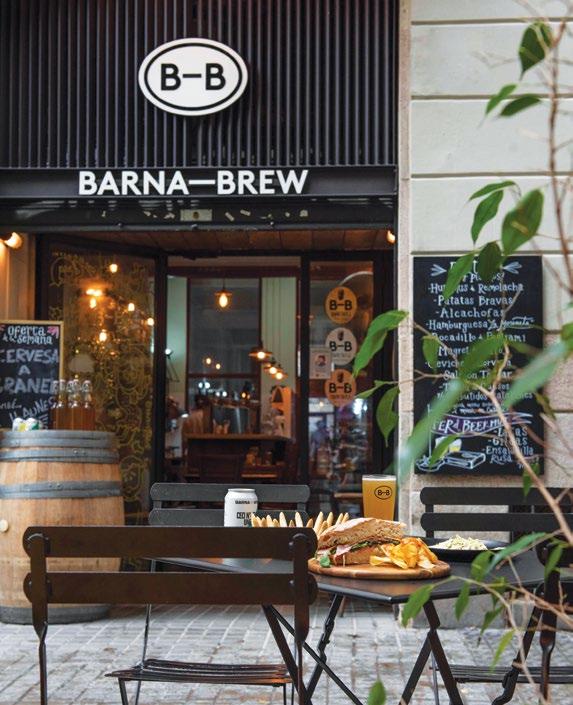
The taproom is very bohemian cool with freshly cooked snacks and sandwiches and also hosts many events.
We held some beer tastings together, including one for Barcelona Tursime which
is something that they hope to continue doing in the future.
The beers produced are Belgian-style with a touch of Catalan – orange blossom honey, Sichuan pepper and bay leaf give the recipes an interesting twist.
I really enjoyed their Blonde dry-hopped with orange peel, Witbier using bay leaves instead of coriander seeds and Moreneta Bruna with toasted malt, cinnamon and curaçao.
Five minutes away is Lambicus, opened by Henk Cortier in 2013. Henk hails from Belgium and decided to open his bar and nearby bottle shop in 2013 when he was struggling to find beers that he liked. As the name suggests, the beer card is predominantly Belgian and it’s an excellent list that would be the envy of many a Belgian beer cafe.
Draft lambic is always on tap and I enjoyed some beauties from Hanssens and Oud Beersel. I have to admit to being very tempted by the exclusives from Antidoot and Drie Fonteinen.
Nearby you can enjoy wonderful craft beers at La Més Petita, a lovely and friendly tiny bar that has been operating since 1996.
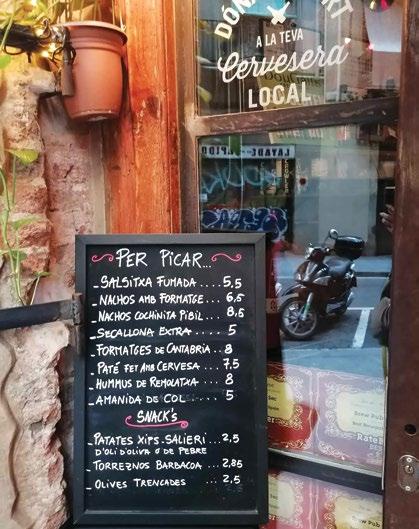

Some of the beers here are hard to find in the city and they also stock their own range from Ratpenat Cervesers.
You pass through Sant Antoni to get to Eixample so it’s an opportunity to visit the amazing indoor market at the end of Ronda de Sant Antoni.
The barrio has transformed itself and is now a lively and progressive district that has attracted many younger families to enjoy its spacious pedestrianised streets, and students that attend the nearby Universitat.
It’s also home to Fàbrica Moritz, which has produced Barcelona’s original beer since 1865 and one that is christened in Catalan. The brewery has undergone a major refurbishment and is recommended for dinner, a couple of beers or a brewery tour. Near-


by is a fantastic taproom, Maresme, owned by the brewery of the same name that began brewing their excellent beer in 2017 in Montgat, a few kilometres up the coast.
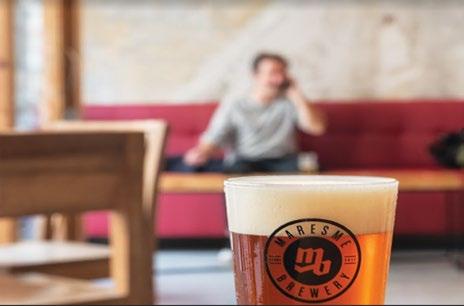


This is a very upscale place with a full range of beers on tap and in can. Expect great food and top-quality events and dance nights. Unfortunately, the beergarden on the beach in Badalona is now closed.
I was very impressed with their German-style beers and the Pils, Helles, Marzen and Bock were all top class. If you’re still thirsty I’d recommend a vis-
it to Bar La Principal or Bodega Berlanga which are both nearby. And if you’re looking for beers to take home drop by Okasional Beer just around the corner from Maresme.
The ambitious late-nineteenth century decision to open up the city by raising the walls gave birth to the city’s Modernisme, Catalonia’s answer to Art Nouveau.
With Plaça Catalunya as the gateway, the city embarked upon construction of an enormous grid of avenues based on Ildefons Cerdà’s design using a network of straight lines, parallels, diagonals and meridians. The district is split in two by Carrer de Balmes, a former railway and this divides ‘The Extension’ into Dreta (right) and Esquerra (left).
Continuing north from Maresme you cross Gran Via (home of the Universitat) and enter the most densely concentrated area of today’s craft beer scene. Rosses i Torrades is a craft beer shop now owned by Cervesa Espiga.




Expect a range of draft taps, craft beer from all over the world and a cool vibe with David spinning some vinyl on the decks. He even takes requests.

Nearby is Conesa Beer, which was started by Montse and Joan Manuel Conesa in 2019. Designed to enable guests with reduced mobility to visit they also released a beer called Am Able to raise funds for continued research into autism and intellectual disability. They offer a great range of tapas and croques and broadcast local football matches too.
Deservedly, BierCaB is probably the most popular craft beer bar in Spain. In 2017, Manolo Baltasar of Cafe Frieberg fame and Sven Bosch of Drunk Monk in Mataro opened the doors of this iconic bar.


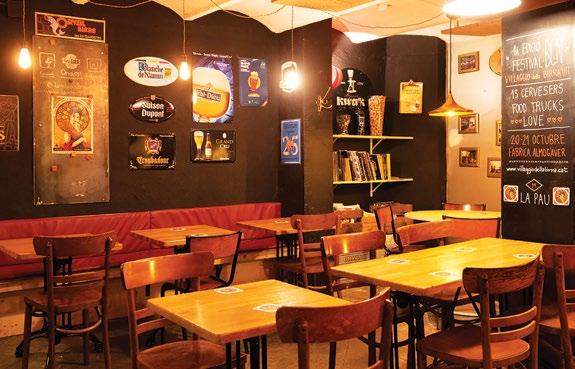

Specialising in perfectly poured draft craft beer the world over this is the place to head to if you just have an hour to spend in the city. Tapas, burgers and larger plates are available but you won’t go hungry as the neighbourhood is full of great eateries (try La Flauta).
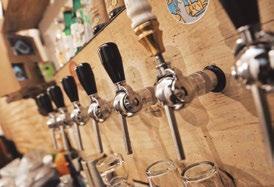

Around the corner you have the original taproom and brewery of Garage Beer Co. This is where they opened their brewpub in 2015 before moving brewing operations to their new site in Sant Andreu.
Another brewery founded by folks from outside of Spain, James Welsh (UK) and Alberto Zamborlin (Italy) were guided (as many others were) by Steve Huxley to the Eixample area where they converted a local paper shop into their brewpub.
You can taste their excellent pale ales and IPAs alongside the complex wild ales that bolster their taplist.
A few blocks northwards you will hit Black Lab’s taproom where you can enjoy fresh beers from their Barceloneta brewpub (to learn more we feature their brewpub in the Outliers section).


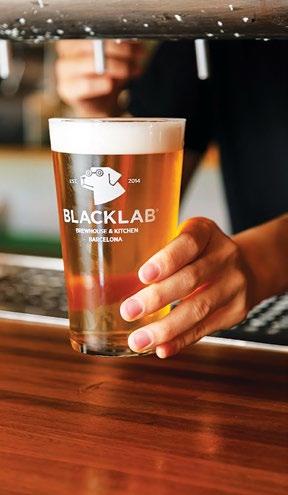

Walk up towards Avenguda Diagonal and you will come across Humble Beer, a really cosy craft beer bar showcasing Spanish craft alongside world classics.
And finally, before heading to Plaça Catalunya and the metro there is Ruta 6, a microbrewery that started pouring in 2019. Fairly new to the scene they are pushing out a range of pales and IPAs alongside stouts, pilsners and sours.
Dreta is the more fashionable district of the two with the most distinguished Modernista architecture, the main museums and shopping avenues. La Textil, founded by globetrotter and master brewer Brian Blazek in 2021, is a brewery, restaurant and music venue.
The food is unbelievable and innovative and uses local and seasonal produce. Pouring out of the 18 taps is the wide range of La Textil craft beers, supplemented by a high-end cocktail menu.
They produce their own gin and soft drinks onsite and the brewery capacity is 1,200hl. Highly recommended.

South of La Textil, craft beer bar Ale & Hop has been pouring refreshing craft beer out of its 12 taps since 2011.

Not far from Parc de la Ciutadella and owned by Alberto from Cyclic (see outliers below), it’s perched alongside a quiet square and is another cool place to hang
out and try some local beers or to attend one of their many beer-related events.
With a range of snacks, tapas and pintxos this is a great place to refresh after a couple of hours exploring.

Heading up towards Gràcia, La Cervesa Artesana is one of the originals and has been serving thirsty beer enthusiasts beers from their microbrewery alongside well chosen guest beers since 1996.
This is the former site of Steve Huxley’s former brewery so its a very historic spot. Great beer snacks and an eclectic programme of live music make this a great spot to while away a couple of hours.
Another bar that serves up a large range of Spanish and international craft beer is CocoVail Beer Hall. Essentially a sports bar, this is the place to hang out to catch a game and eat from their US-inspired menu. Just short of the boundary with Gràcia,



The Growler has a familiar beer-geek vibe, pouring pints and take-away growlers. They also have some tables outside if you don’t mind the noise from the traffic.

If you’re looking for some food with your beer try Hop Town near Monumental where you can enjoy empanadas and pizza with your craft brews.
Finally, an exciting new project has opened recently: WU:M offers an innovative fusion of Japanese and Mediterranean vegetarian food that features beers from Animus among those of their friends (see ‘Outliers’ for Animus).
East of Poble Sec, El Raval (outside the walls) has had an unfortunate reputation in the past for seedy lowlife and while it has altered its monochrome grimy face
for the better over the years (check out the post-Olympic Rambla del Raval), it still retains a steely hard edge.
Opened in 2015 by Mads Rademacher and Ivan Raho, Ølgod (beer god) began life dedicating itself to beer from Scandinavia.
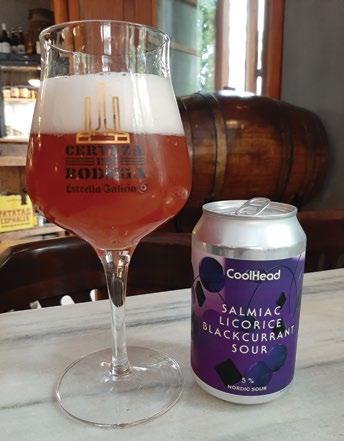


Since opening their on-site microbrewery you can now enjoy tasty and ultra-fresh craft coming direct from the tank to their range of 20 taps.
Great food and a dedication to quality music has made this a must-do destination for beer lovers. A short walk away is Garage X Warwike where you can fill yourself up on Peruvian street food and wash it down with Garage beer from the 18 taps on the bar.
Hop across La Rambla and you enter the realm of shadowy medieval alleys, grand churches and ancient ruins in the political and religious heart of the Old City (Barri Gothic). I could write a piece on its own about this fascinating barrio whose lurking and brooding narrative springs to life late in the afternoon.
You can quench your thirst on the 17 taps at Kælderkold (cold basement), which is also owned by Mads from Olgod. Most of the beers poured at this dive bar are from the sister site’s brewery but they also showcase a strong line in guest beers.
Halfway between the Picasso Museum and Parc de la Ciutadella is Diec18, whose kitchen is supported by an impressive range of craft beers and natural wines.
While it doesn’t have any commercial breweries, Gràcia does hold claim to the best neighbourhood bar in the city. La Rovira is host to 18 constantly rotating taps, numerous bottles and cans, excellent tapas and grilled sandwiches (named after the surrounding streets), a killer playlist and a team that is well drilled, professional, knowledgable and offers a great welcome.
They always looked forward to greeting our little Jack Russell Penny Lane with a treat, bowl of water or simply hugs and kisses.
Noe Guarner established her bar in 2015 and quickly built a strong reputation for an outstanding range of expertly curated beers.
This is a bar where everyone knows your name and should you venture in on your own it won’t take long before you are discussing the topics of the day with your new best friend.
There are La Rovira collab beers on the list, plus the ever-impressive wild ales from Cerveza Salvaje.


It is well placed on the corner of Plaça Rovira i Trias and is named after the architect Antoni who would have been the local choice to design the city’s nineteenth city expansion.
You can sit down with his statue on his bench and enjoy a beer while indulging in a spot of people watching.

In the south of the district is Bar La Beata, pouring 8 taps of fresh local Catalan beer, their own commissions and regularly producers from the Basque region.

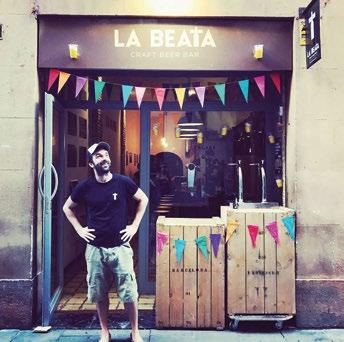
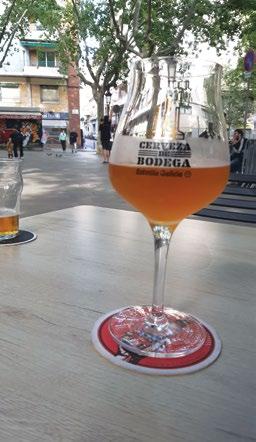


Small and cosy, it’s always easy to make friends here. Brew Home isn’t a bar but a destination where you can enjoy some ‘beerstorming’ pairings with Dani Ruiz or learn about brewing at one of the many workshops held there.
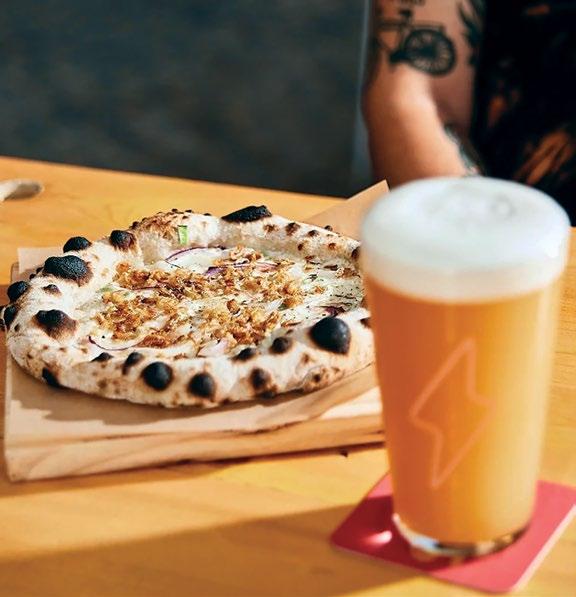
While you are at it you can top up your stash with his wild beers from Cerveza Salvaje. Probably the best beer shop in the city is on Plaza del Sol.
Sol de Gràcia stocks an unbelievable range of beers featuring a huge Spanish offering plus a large selection of beer from the UK, Ireland, Belgium, Germany and the rest of the world.
Some of the beers I was able to buy at the shop were hard to find in their country of origin. A new kid on the block is Beer&Cocktails, complete with a beer engine.
Finally, close to La Sagrada Familia is Espiga’s other craft beer shop, which features the full range of beers from Arnau Rovira’s brewery. They also have four of their beers on tap and host regular events.


Part of the Sant Marti district, Poble Nou morphed from a farming and fishing community into a centre for heavy industry up unto the 1960s when many of the factories folded or moved away. Relics of its industrial past are in evidence everywhere and former sites have been re-purposed into schools, civic centres, workshops and open spaces.
The artistic community has been part of a drive to make this a cool and hip area to live and work in and that has encouraged the growth of craft beer in the neighbourhood.
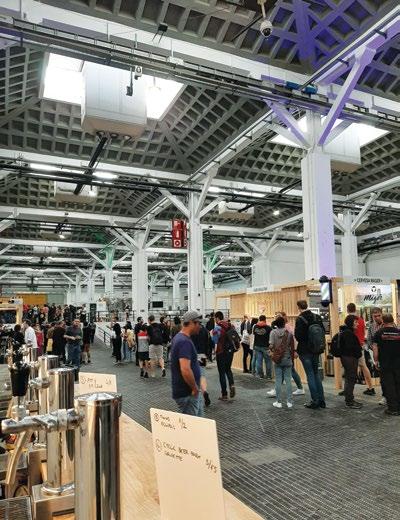
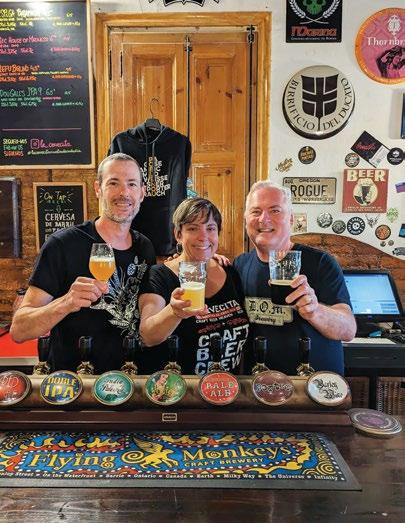
Garage (who else?) has a site just a short hop from Playa del Bogatell. Specialising in pizza to complement their range of beers the site has a good sized terrace out front. Head east to Cerveceria Ogham from Argentina who have taken over the former site of Freddo Fox. Nearby Hoppiness is pouring local brews and beyond from 14 taps. Nice and relaxed with alt sounds on the playlist, Hoppiness is praised for its grills and burgers. They have another outlet in Sants near Plaça Espanya.
One of the city’s finest beer bars is located in Poble Nou. La Cervecita is summed up by their strapline ‘nuestra de cada dia’ or ‘our beer of every day’.

Angie Gesteira and Joaquim Sainz have created a friendly space that is truly the essence of beer with a dozen taps, three beer engines and over 300 bottles. Highly recommended.

Taking advantage of derelict industrial sites Almogàvar – Beer Democracy took over a 2,000sqm warehouse in 2015 after six years of cuckoo brewing. Founded by Victor Cerdan in La Verneda i la Pau and consolidated when master brewer Francesco Stella joined from Italy they have really made their mark and you can easily find the beers on market shelves in the city.
The site is big enough to allow for expansion and importantly to hold many events, as their relationship with the local community is very important. El Clot boasts the craft beer workshop Birra 08. Since 2010 the team has been brewing beer, hosting tasting events and offering brewing workshops.
About a 15-minute walk from Almogàvar is Cyclic Beer Farm, which was established by brothers Alberto and Joshua Coromina in 2016. Inspired by Belgian saison, Cyclic specialise in mixed fermentation and have developed their own yeasts and bacteria cultures which they sometimes supplement in their beers with fruits, vegetables, herbs and flowers – some of which are grown on their own family farm and some coming from local ecological farmers.
They also produce traditional wine and have used the macerated grapes in their mixed ferm beers. Nearby is an excellent venue for lunch with local craft beers, La Floristeria de Masadas on Plaça de Masadas.

And if you head towards Congrés metro station later you can sample some of the excellent beers at Cerveceria 2D2Dspuma with its 9 taps and over 600 bottles and cans.
Walking towards Platja San Sebastian from Barceloneta metro station you will pass the
enormous Museu d’Història de Catalunya or the Waterside Catalan history museum.
As you walk around it you will spot an outside seating area where customers are tucking into craft beers and Asian/US inspired bar snacks.
Black Lab Brewhouse and Kitchen was founded in 2014 and this is the location of their brewery. We’ve always had excellent and friendly service from the team and this is a much-needed stop on a sunny day before heading to the beach.
East of Gràcia and the Parc Güell Animus Brewing Company was born out of lockdown in 2020. Founded by Peter with the support of his girlfriend Constanza, Animus has quickly grown a huge following and became one of the highest-rated Spanish craft breweries on Untappd.
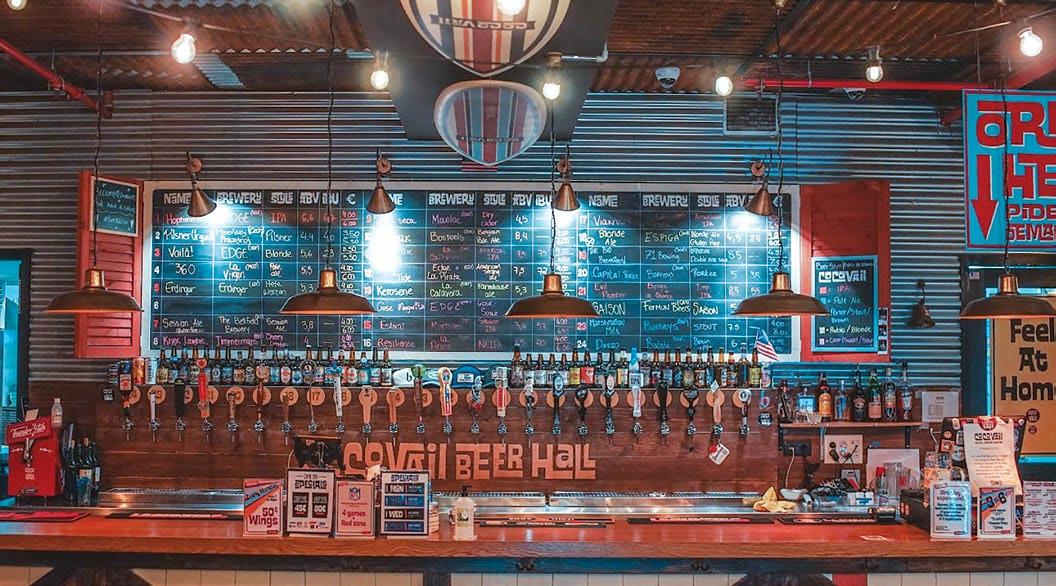

The philosophy at Animus is as a collective – grow their network of beer friends globally, make collaborations, host events
and celebrate beer at their taproom and restaurant WU:M (see above, Dreta).
Formerly the industrial town Santa Maria de Sants, this neighbourhood officially became part of Barcelona in 1897 and stretches east from Eixample.

Giant textile factories were established here and their wealth were in part responsible for some of the Modernista projects such as Can Batlló and the Parc d’Espanya Industrial. It is home to the Plaça Espanya and the main railway station Barcelona Sants.
And just north of the N340 is the brew pub Homo Sibaris. Formerly of La Cerveteca and Humulus Lupulus, Guillem Laporta opened his bar where he and his friends brew their own beer.
The terrace on Plaça d’Osca is the perfect place to sample their brews or enjoy a guest or two.
West of Sants L’Hospitalet de Llobregat is the main centre for Flamenco, with its large Analusian population – many streets are signposted in Spanish not Catalan. The neighbourhood is proud of its identity, with LH stickers everywhere and even
street signs guiding you in the direction of Barcelona (a few blocks away).
Here we find Tibidabo Brewing, one of the largest microbreweries in Spain. The brewery has sufficient production space to take on contract brews and I easily found their beers available in most supermarkets throughout Gràcia. The taproom is spacious and lively with a window into the brewhouse.
We also had time to host some tasting events and tours and just squeezed into the Barcelona Beer Festival the day before leaving.

A month is a long time to spend in any city yet I still get moments of FOMO: what else is there to see and discover, which neighbourhoods still need visiting?
Perhaps next time we’ll hit the road and explore the regions around the city. The pull from the city can feel like a riptide at times. It wants to reel you back in to show itself off like a child with new toys at Christmas. To welcome you and allow you to peel away more of its layers. I feel it will soon be time to go back – but until then, Salut!
About the author:
Paul Davies, AleHunters Tours
On my journeys I have amassed a huge amount of knowledge of the country’s bars and breweries, and built up a network of contacts with the key people involved in Belgian’s vibrant beer scene.
A resident of London for over 35 years I have developed an in depth knowledge of the capital’s most iconic pubs and bars. More recently I have spent the past 10 years exploring the most innovative and exciting craft breweries in the city. In a previous life, I was a member of the Quality team at Fuller’s, London’s oldest brewery.
I also delivered brewery tours at its Griffin Brewery in Chiswick, welcoming visitors from the UK and overseas. I have hosted tutored beer tastings for many years, and have a thorough knowledge of beer – from grain to glass. I look forward to sharing my knowledge, enthusiasm and experience with you.
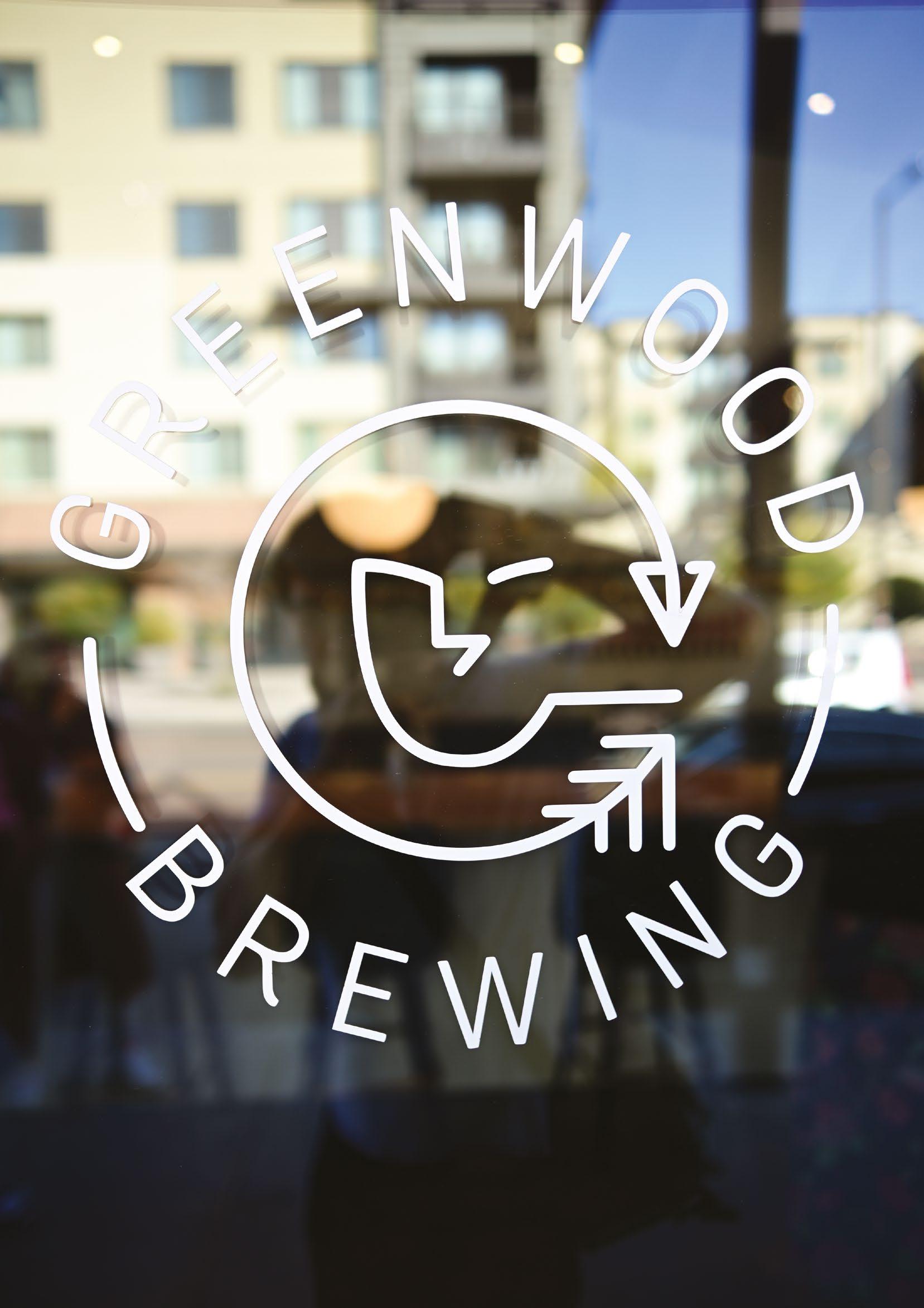
Women’s presence in the beer industry in North America is ever-expanding, and with this growth we are witnessing women-owned beer businesses pushing boundaries for change and equality. For Roxane (Roxy) Brossoit from Montreal, and Rachel Benkowski from Phoenix, it is this expanding presence of women in the beer industry that inspired a unique business opportunity. What ultimately blossomed into the now international nonprofit organization called the Beer Babes Family, began with a simple mutual interest in beer.
“All of this came to be purely by osmosis. Nothing was planned, and we had no foresight into what the Beer Babes Family would become. We were just two women who appreciated beer, and who loved sharing that passion with other women.”
The Beer Babes Family is a nonprofit organization in the United States and Canada. The organization’s mission statement is to collaborate with breweries throughout North America to help raise money for the Beer Babes Family Grants Fund. This funding is awarded to women in the beer industry trying to improve their beer business.
The Beer Babes Family is a product of COVID. After meeting on social media in the summer of 2020, Roxy and Rachel began an online interaction group for women sharing their beer drinking experiences on Instagram.
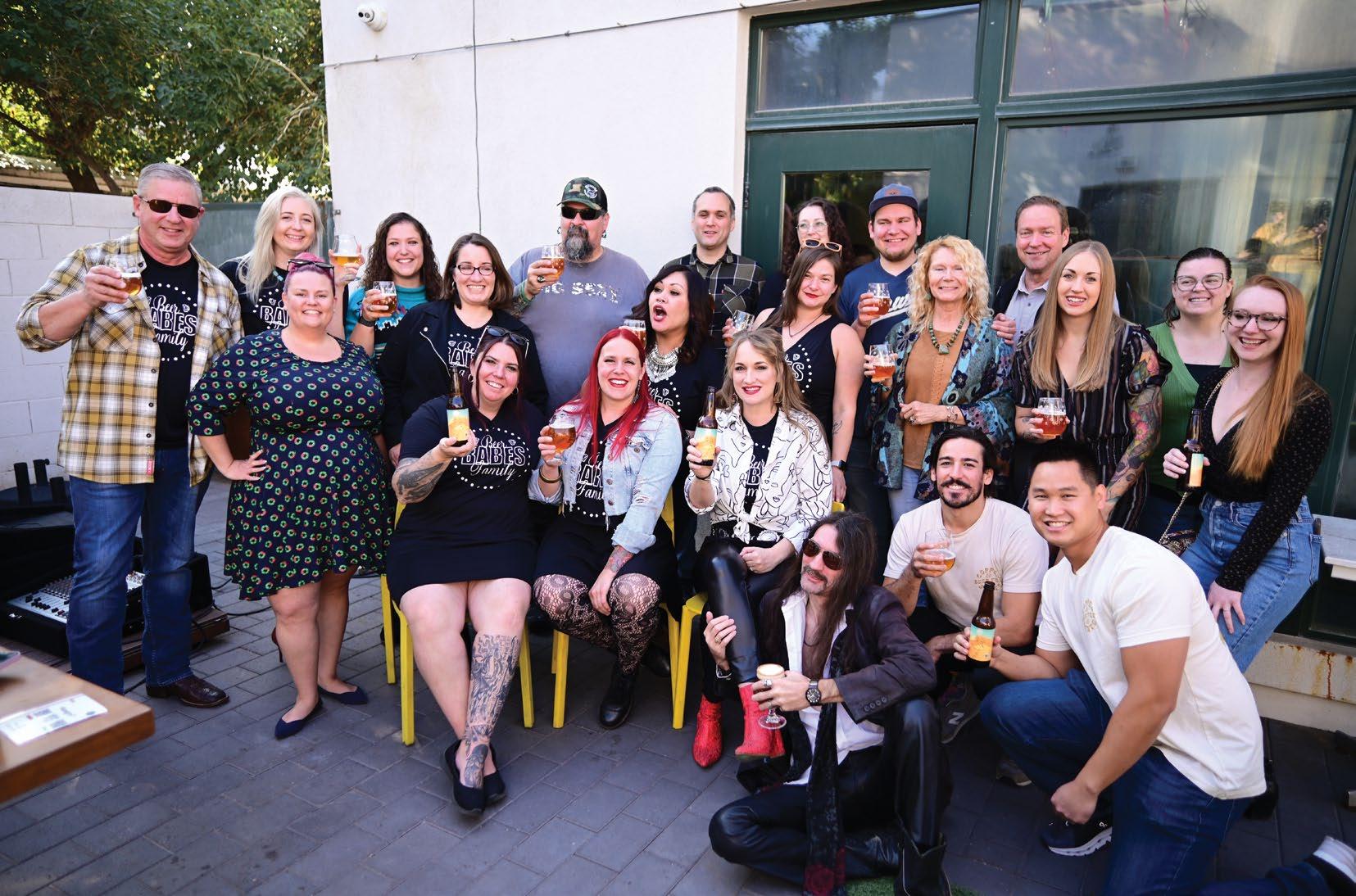
As a fun social outlet, they named the group “Beer Babes Family.” As the women in this group from around the globe started using the hashtag #beerbabesfamily, questions began arising such as “What is the Beer Babes Family?” and “How do I become a part of the Beer Babes Family?” While the initial group was just for fun, the growing interest in “What the Beer Babes Family was” brought pause to Roxy and Rachel, and they began asking themselves “what could we turn this small community in to?”
As the online community began to grow, there was outreach from homebrewers and breweries interested in how they could participate. What made the most sense to Roxy and Rachel was to brew beer and have proceeds from the sales go to a woman-focused charity. In February of 2021, the Beer Babes Family’s first collaboration beer helped raise money for the Pink Boots Society.
After this first collaboration beer, there was more and more interest in the Beer Babes Family, and Roxy and Rachel had the se-
WHAT STARTED AS A MUTUAL INTEREST IN BEER HAS BECOME MUCH MORE, EXPLAINS RACHEL BENKOWSKI, CO-FOUNDER OF THE BEER BABES FAMILY, AN ORGANIZATION THAT STRIVES TO SUPPORT AND POSITIVELY ENGAGE ALL WOMEN IN THE BEER COMMUNITY. THIS INCLUDES THE CASUAL BEER DRINKERS TO THE HIGHEST LEVEL OF BREWERS, CICERONES AND BEER JUDGES.
rious conversion of, “What if we become our own charity?” Because both women work in the beer industry, and over the years had witnessed many women pursue careers in beer, it made sense to them to create a charity that would help support women in the beer business.
“We didn’t want to compete with the Pink Boots Society, so we decided to focus on business–a place where we felt we could make a big difference for someone. We love seeing women taking the reins and starting their own breweries, taprooms, and other beer-related businesses. Since we are both in the beer industry, that is what we wanted to support.”
After becoming an official nonprofit organization in the USA in April of 2022, and then the same in Canada in December of 2022, the Beer Babes Family has been raising money through collaborations with breweries throughout North America. These collaboration beers are called Babe Brew™. In 2023, the organization will collaborate with one brewery per calendar month (with locations ranging from Montreal, QC to Glendale, CA), with portions of sales being donated. In 2023 their goal is to give $5,000.
“Babe Brew is a series of beers dedicated to the women of our personal lives and of the world: who inspire us, push us, make us think deeper, mentor us and lead by example. To the women who break rules and norms, speak their truth with compassion, live each day with unapologetic confidence, and champion equality for all.”
So what does a brewery need to do to be involved with the Beer Babes Family? It is simple, be a brewery with a good reputation for equality and supporting women and women-identifying people in beer.
Participating breweries brew beer, which is then packaged and sold, with proceeds going to the Beer Babes Family. The Beer Babes Family does not sell directly to consumers. The amount of money donated will be established with each brewery individually, depending on the brewery’s size, costs, needs, etc.

There are no parameters regarding beer style brewed. Individual breweries’ talents and specialties are desired to be showcased. If your brewery does not have the capacity or ability to brew an entirely new batch of beer, that’s ok! Some breweries choose to “rebrand” one of their flagship beers as Babe Brew (for an allotted time chosen by you), and then donate a portion of the proceeds being donated to the Beer Babes Family.
It’s not all about the beer though. The Beer Babes Family continually strives to cultivate their community, and encourages involvement with the charity. For example, on brew
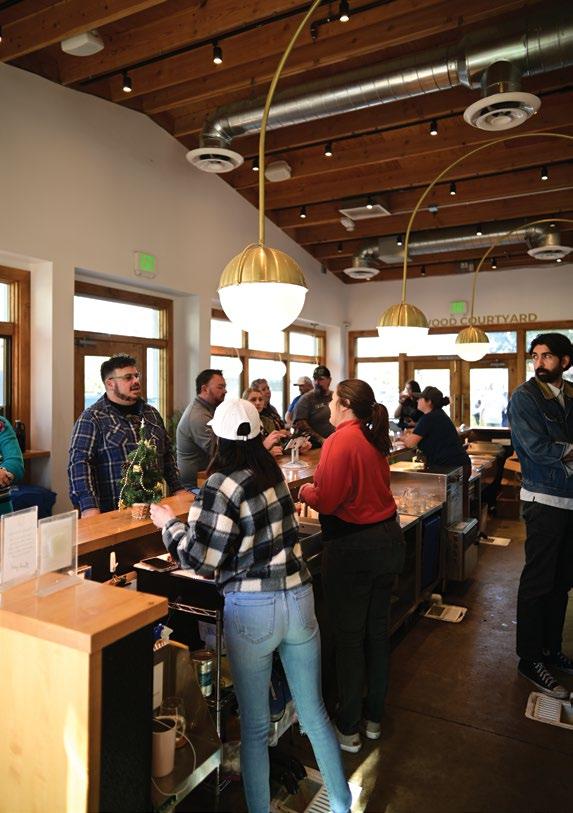


day, supporters of the Beer Babes Family are asked to join in on the brewing process. Whenever possible, Roxy and Rachel make it a priority to travel to meet the people who brew, serve, and drink Babe Brew. In 2023 one or both of these women were–or will be–present at each release. Then there’s the party! Each release of Babe Brew is treated as a fundraising event. It is common for supporters to travel across the continent to be at these releases. For example, in April 2023 at the release of Babe Brew 11 in Fort Lauderdale, FL, at Yeasty Brews Artisanal Beer, women traveled from South Carolina, Oklahoma, Washington, Pennsylvania, and Toronto to support the organization.
“We strive to ever-encourage involvement from our supporters. This charity started as a community of beer-drinking women, and we want to keep that as one of our core values. It’s flabbergasting to us how a social media interaction group started during COVID has turned into an international nonprofit. But we are stoked for the future.”








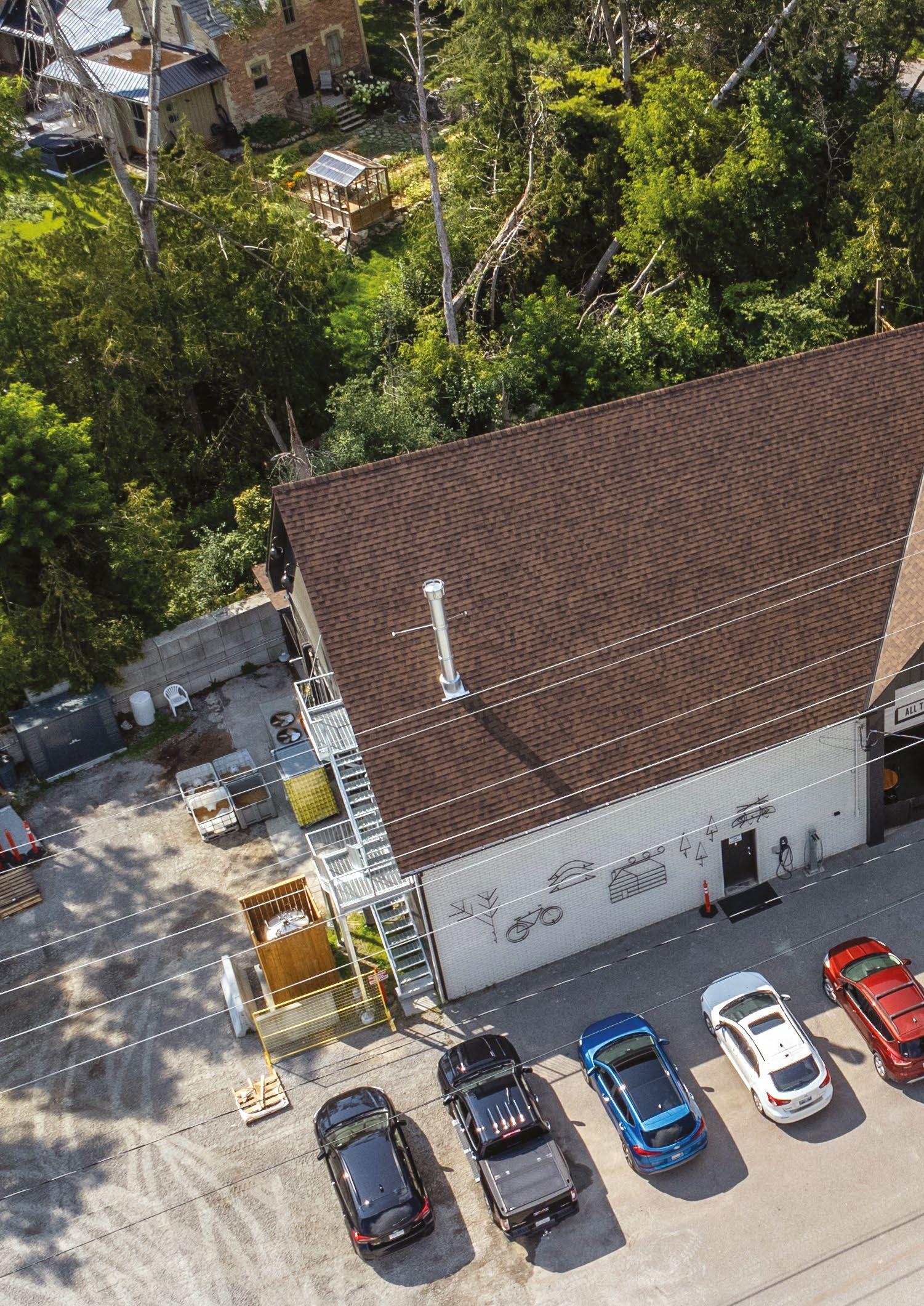
WHILE MANY BREWERIES ARE STILL COMING TO TERMS WITH THE IMPACT THE COVID-19 PANDEMIC HAD ON THEM AND THEIR BUSINESSES, THE SECOND WEDGE BREWING CO HAD TO CONTEND WITH THE DEVASTATING IMPACT AN EF-2 TORNADO HAD ON THEIR UXBRIDGE FACILITY LAST YEAR. BUT THANKFULLY, DUE TO HARD WORK AND OVERWHELMING SUPPORT, THEY ARE BACK ON THEIR FEET.
The release is huge. It’s funny, because it’s not like there’s a switch that you can just turn on and everything is back. It’s very much a process. For us, it feels like we’re climbing down from this crazy mountain and gradually getting in tune with normality. And you know what, it feels like the air is better down here!”
For Joanne Richter and Rob Garrard, the co-founders and owners of The Second Wedge Brewing Co, the last 16 months have a challenge, followed by a hurdle, followed by an obstacle. But thanks to their resolve, the team, as well as the brewersjournal.ca
community and fellow brewers they’ve overcome them and this summer, the Uxbridge-based brewery was able to open its doors once more.
Located just over the second wedge of the Oak Ridges Moraine is The Second Wedge Brewing Co, a locally owned brewery inspired by the beauty of the Uxbridge trails, dedicated to igniting passion for craft beer in their community and beyond. More than just Uxbridge’s neighbourhood brewery, they are a community meeting place and a strong supporter of local music, art and small business collabs.
Since opening in late 2015, their tasting room, bottle shop and beer garden have gained loyal fans in town and attracted visitors from throughout the GTA, across Canada and overseas. Their wide range of delicious handcrafted beers on tap, beautiful space and friendly, welcoming vibe has long made The Second Wedge a standout for beer-to-go or an afternoon of enjoyment.
But, as many of you will have no doubt heard, last May an EF-2 tornado hit Uxbridge, Ontario. A local state of emergency was declared. The tornado caused ex tensive damage includ -

ing downed power lines, uprooted trees, and extensive property damage. Among those hit were The Second Wedge Brewing Co. But thanks to local support and a huge helping hand from Market Brewing in nearby Newmarket, the brewery was slowly able to get back on its feet.

According to the Northern Tornadoes Project (NTP), which surveyed a long, narrow path of damage in the city, they estimated that the path of damage measured 4.26 kilometres in length with a maximum width of 260 metres. The EF2 tornado likely occurred around 1:15 EDT with a maximum speed of 195 km/h. Unfortunately The Second Wedge Brewing Co would not escape its path.
“Immediately after the tornado struck, dozens of people from the communi -
ty came out to the brewery to see how they could help – moving away debris, rescuing things from the building, helping with our dog or just offering our staff a shoulder to cry on,” Joanne Richter, the brewery’s co-founder and owner told us previously.
She said at the time: “For at least the first two weeks we received non-stop phone calls and messages from our Uxbridge community, our restaurant and retail customers, and breweries across Ontario, offering help, meals, temporary jobs for our staff, cash donations, storage space, production space, pop-up events and on and on.
“Those first few weeks, emotions were very intense – we were coping with the destruction of our brewery, while also feeling so grateful that no one was badly
hurt, and being absolutely flooded with love and support.”
And Market Brewing, based some 28km west of the brewery, were integral to that support. Piers Simpkin, general manager, previously said: “When I saw the initial aftermath we reached out immediately to see if there was anything we would be able to help with as I couldn’t imagine this happening to Market right after all the pandemic struggles and just when it’s looking to be the first ‘normal’ summer in two years.”
Fast-forward little more than a year and thanks to that help, Joanne and the team are back on their feet. While the investment in a new heat exchanger was required, thankfully other kit such as a new canning line escaped the tornado damage.
“The ongoing relationship with Piers and the team at Market is just… forever friendship. Those guys have been amazing. It’s been a long process moving back, installing and moving the tanks in stages but we’re very excited to come home - there has been a lot of unpacking!” she laughs.
When the weather improved earlier this year they were able to open their beer garden. They were even able to mark their “tornado-versary” serving drinks outside.
Partial occupancy followed ahead of a full-reopening in the middle of July this year. “The way we’ve always done it is sort of set a date, however realistic it is, and then work hard to it and make it happen,” Richter smiles.

The first day we opened the beer garden felt like a wedding. Everybody made time to come out, and to wish us well.”








And the process of being closed, then reopen in stages, understandably brought back recent memories of the pandemic…
“It was all familiar territory to have touse the dreaded word - pivot. But maybe COVID was good training for us to handle this. Without the experiences of that prior, who knows, maybe we would have collapsed,” she muses. “Without knowing how to manage things, and had we just been struck by a tornado out of the blue, it would have been more challenging to acclimatise ourselves to constantly changing our operations.”
While The Second Wedge brew a wealth of different beer styles, the focus understandably still remains on producing their core beers - 3 Rocks IPA, Elgin Blonde blonde ale, Monday Night Piper Scottish-style ale and Rain Maker porter. But Richter says fans of their beers can rest assured they’ll be brewing a broader range of beers as “normality” resumes.
“We are longing for that creativity,” she says. “Our core beers make us happy, that’s why we brew them all year-round, but we are still playing catch-up and can’t wait to start doing more seasonal and limited beers once more.”
The beer-loving community of Uxbridge and beyond no doubt understand. And it’s their support that has helped get the brewery back on its feet.


“Nothing cements your relationship with the community like tragedy or chaos,” says Richter. “The amount of support, and the outpouring of love has been incredibly uplifting. And it’s just what we needed to get us through.”
She adds: “The first day we opened the beer garden felt like a wedding. Every-
body made time to come out, and to wish us well. The party atmosphere was fantastic. And then the day that we were able to welcome people back inside the building, was just magical.
“The people have been waiting, and we hear it all the time - ‘It’s just not Uxbridge without you’.”
And that support has come from many sources over the years. In a previous life, Joanne Richter worked for the Canadian National Institute for the Blind while brewery co-founder Rob Garrard was a freelance cameraman in the TV industry.
Both professions involved long commutes and sustained periods of time away from home. A desire to be part of a community and to spend more time with family is what led the duo to Uxbridge in 2004. Ten years later they
would announce their plans to open a brewery in the town, something that would eventually happen in late 2015 thanks to a lot of hard work, commitment and support from local investors. Rob Garrard was even able to turn back to his former career for assistance and guidance, with a construction team that he worked with on a renovation TV show helping with the build.
Back to the current day, and following (re)construction of a different kind, Richter says the team is proud, exhausted and relieved.
“Had we been told that the brewery needed to be torn down completely, I’m not sure if we’d be talking about the future of The Second Wedge right now…” she says. “But being able to salvage some of the building really helped us. And our landlords are also investors in the brewery, so they believe in our ability to survive and also thrive.”
She adds: That vote of confidence has really allowed us to charge forward and say ‘let’s keep this business going’.
“Now we are experts in overcoming whatever is thrown our way. We roll with the punches but I’ll tell you what - I hope we never have to pivot again!”
We all want to find our niche, somewhere we belong. For Perth Brewery of Eastern Ontario, they already knew they made great beer - enough customers certainly told them so. But that same beer is also naturally gluten-reduced and, as a result, Perth has become the go-to for thirsty beer fans across the province and beyond.


It’s finally here. A time that perhaps many Canadian brewers would have not seen coming, but Non-Alcoholic Beers (NAB) and Low-Alcohol Beers (LAB) are finally having their moment in the world of craft. While new techniques, advanced products and process innovations are always top of mind when framing the emergence of new product classes in the craft sector, nothing quite presents the opportunity for diversifying a brewery’s portfolio like NABs and LABs.
In a new age of consumption consciousness it is evident that limiting total alcohol intake is a key determining factor for a wide class of consumers and for a growing many, the expectation is that their experience remains the most craft adjacent as possible.
Although on paper the process should not be too dissimilar to conventional brewing, there are some distinct and extra challenges to getting it right. In this article we will explore aspects of food safety, key ingredient selection and the brewing technique needed to achieve that perfect” that tastes exactly like beer!” result.
A short disclaimer: NABs and LABS should be brewed with caution. The
very nature of these styles make them more susceptible to cross contamination, including spoiling agents and potential pathogens.
Conventional beer is an inherently safe product to consume simply due to the variety of natural barriers present in the brewing process that limit unwanted bacteria from making their way into the finished product.
The nature of NABs and even LABs however, make it harder (or even impossible) to have some of those seemingly natural and common barriers that would be present in the conventional process. That being said, it is entirely possible to execute a safe and consumable NAB or LAB in the craft space, with the proper attention being paid to ingredient selection and especially, technique.
*If attempting to add a low alcohol product to your lineup, it is crucial to familiarize yourself with Canadian food safety guidelines.
In conventional brewing, pairing the three main barriers of safe production: alcohol, pH and hops, along with proper sanitary brewing practices, is the best and most simple way to keep spoiling agents and pathogens out of your favourite beverage. Unfortunately in the case of NABs and LABs, we are avoiding some of those barriers, like alcohol, on purpose and then others, like pH, by result.
The presence of alcohol naturally prevents certain bacteria from feeling at home in solution, but with its absence, makes other hurdles much more important to maintain. A safe zone for pH in beer is under 4.3pH, which tends to be easily achieved in conventional brewing, but deliberate acidification using various food safe acids is necessary to help LAB yeast achieve the same safe low pH.
As brewers, we all know that consistency in brewing is often hard won and the presence of unintended spoilers to our process are naturally abundant in our work place. For most breweries however, these threats are known and managed to effective low risk – like Lactobacillus.
Every brewer knows the struggle of consistency when it comes to brewing a beer. While it is important to keep a sanitary work environment and respect the barriers in beer, it can be a challenge to keep an unintended beer spoiler such as Lactobacillus out of a brew. For most breweries it is a relatively low risk.
Much more dangerous pathogens like botulism however, become part of the conversation when talking about NAB and LAB brewing, at any size of production. These bacteria thrive in high protein environments and the lack of inherent barriers to stop toxins from entering the product at key production stages pose
a serious and significant threat; making distinct and extra steps (like pasteurization) necessary to keep the final product safe for consumption.
Pasteurization is defined as the partial sterilization of a product, using focused heat to eliminate bacteria. It is the most important barrier we can provide in this discussion that protects beer from both spoiling agents and pathogens and the ability to guarantee this step in production should be a significant determining factor when considering brewing a safe NAB or LAB.
Our industry has largely avoided scrutiny when it comes to food safety, but that story can and would change if these safety measures were not met with the level of care and attention required to produce NAB and LAB to Canadian Food Safety standards.
The popular techniques that exist to create NABs and LABs all aim to reduce the amount of alcohol present in the finished beer while maintaining the truest degree of flavour. The more popular and costly ones utilize equipment not native to most craft breweries, such as de-alcoholizers and pasteurizers.
While we highly recommend the latter as a tool to create the safest consumable product, even with the former employed in tandem, proper ingredient selection is still paramount to maintaining the beer’s overall integrity.
The mashing process is the first step to help limit the potential for alcohol to be present after fermentation. A low fermentable wort can be achieved by selecting grain with limited fermentability potential, such as using Muntons Dextrin malt or IREKS Spitz malts. They will help with both body and mouthfeel by contributing long unfermentable sugar strains, that will limit diastatic potential. After grain selection, the unique mash process itself is an important consideration.
A normal mash regiment is used to break down proteins and starches in the malt by activating the present enzymes in the grain. It aims to create a healthy balance of short fermentable strains of sugar for the yeast to consume and longer more complex strains of sugars that the yeast will avoid.

High mashing temperatures of 72C-86C help limit enzymatic activity in this first crucial step, which limits the amount of available fermentable sugars. This should reduce the amount of glucose broken down and leave the wort with maltose, maltotriose and larger sugar molecules.
Yeast is an important key to producing a NAB or LAB, even when considering employing specialized equipment to remove alcohol. Less simple sugars naturally limits fermentation and the lower the alcohol needed to be blended out or outright removed, the better. There are many yeast strains available on the market that can produce this optimized state - White
Labs WLP618 - NA All Day being one that also produces great flavourful compounds as well.
Like many (but not all), this strain can only ferment glucose, sucrose and fructose meaning a complex mash will offer very limited options for this yeast to ferment. Lallemand has also recently hybridized a non-GMO Non-Alc yeast strain called LoNa.
Unlike other bio-prospected yeasts, it is maltose negative while also being POF (phenolic off flavour) negative; a unique and eagerly welcomed combination in the marketplace. It has a much more neutral flavor contribution from the yeast that can blend easily with alcohol positive yeasts, while contributing less sulfur and diacetyl during fermentation.
In closing, to paraphrase Chris White on non-alcoholic beers: “we as an industry must realize that most NAB drinkers don’t describe them the same as regular beers.” The perfect non-alc is a common goal for many brewers but we might need to change our perception of what this style is in order to brew not just a good non-alc beer but a great beverage.
Ingredient selection, process and a magnified consideration of food safety regulations will help us achieve this goal in Canadian craft and allow us to open up our industry to a whole new generation of consumers who eagerly want to support their local craft businesses.
Yeast is an important key to producing a NAB or LAB, even when considering employing specialized equipment to remove alcohol,” Maxim Samure, Brew Culture
WELCOME TO GOOD NEIGHBOUR BREWING, A FORCE FOR GOOD IN WINNIPEG, MANITOBA. FOUNDED BY MORGAN WIELGOSZ AND AMBER SARRAILLON, THE BREWERY PRODUCES A RANGE OF EXCITING BEER STYLES FROM CZECH PALE LAGER TO MARGARITA GOSE, AND A LOT MORE BESIDES.

Have you been lucky enough to try ‘Cold Tea’ from Good Neighbour Brewing yet? It’s a Rice Lager steeped with Rose Hip and Hibiscus Tea. Delicious, right? Not only is it a beautiful beverage but like many great beers it has a story, too.
“Back when we were living in Toronto you’d go out for a night and before long find yourself in a diner in the early hours,” recalls Morgan Wielgosz. “Amber and I would ask for a cold tea and you’d be served a tea pot but instead of tea being inside you’d find a a lovely beer instead.
“It was well past legal drinking hours so that’s how some places could get away with it,” she smiles. “And the beer would have this beautiful nuance thanks for the amount of tea that’s been in the pot all day.
“And we knew that when the day came to do something ourselves, we needed to conceptualise that idea. So our Japanese-style Lager with those ingredients is our way of recalling that experience. We want people to enjoy what we do, and hopefully we can take them on a journey while doing that.”
Good Neighbour Brewing was founded by Morgan Wielgosz and Amber Sarraillon in 2021. Business partners and life partners, the duo had previously worked


together in Amsterdam Brewing Co in Toronto and also at Winnipeg’s Trans Canada Brewing Company.
“No surprise, we’re both incredibly passionate about craft beer, and it just so happens we were lucky enough to find this passion early enough in our lives to build our careers out of it (over 3 decades combined!),” says Sarraillon. “We’ve spent much of our lives exploring beer all over the world but eventually, all roads led us back to Winnipeg - our home and one of the most special places on earth.”
For Wielgosz and Sarraillon, the idea of starting their own brewery came with a vision, too. They both agreed that they wanted to build something that is bigger than just beer. “Something bigger than ourselves,” she added.
“What we are hoping to do is to inspire our community through our beer, collaboration, and a combined effort to bring friends, families, and neighbours together over a shared thirst for inspired beers and honest connections.”
Their long-term vision has always been to build a small neighbourhood brewery in Winnipeg, and in order for them to achieve this dream, we had to root our beginnings by contract brewing while building a brewery home of our own.
Thus, enter Sean Shoyoqubov and the Oxus Brewing team - in the spring of 2021. Their contact brewing adventure began when Shoyoqubov welcomed them into his space as a temporary home for Wielgosz and Sarraillon to brew their beer. In April of 2021 they released their very first Good Neighbour beers (Hazy Pale Ale, Bumbleberry Milkshake Sour, and the beloved Czech Premium Pale Lager) and since then they’ve brewed more than 100 beers!
“We are incredibly grateful and humbly recognize that the space Sean and the Oxus Brewing team provided played an integral part in the journey that led us to achieving our dream of starting our own brewery! As we prepare to “leave the nest”, we realize how much we will miss seeing and laughing with our Oxus brewing family - we wish them nothing but the best,” says Sarraillon.
Their journey continues with The Beer Can, Winnipeg’s largest outdoor beer garden that “pops-up” during the summer months in the parking lot of the Granite Curling Club - which is central to some of Winnipeg’s most iconic neighbourhoods, landmarks and surrounded by the river, trees and greenspace.
“The Beer Can team is a collective group of incredible people who are passionate about uplifting and supporting our local community (and breweries). They have created a really unique space (that they built with their family and friends!) that is inclusive, mindful and energising,” says Wielgosz.
Early 2021 they had the idea to call up Brad Chute and Neal McDonald (co-owners of the Beer Can) and throw a wild idea at them - for Good Neighbour to purchase and build their own C-Can bar and pop it into their forest area for the summer as an almost pop-up Good Neighbour Taproom where they could sell and feature their beer, meet people, and share their story.
Sarraillon adds: “Wild, bold idea right?! Long story short, they agreed and our lives changed forever.”
They popped-up at The Beer Can for two beer-filled summers and are also in the midst of another season. “Brad, Neal and their families alongside the great crew who work at The Beer Can have quickly become our family and we are incredibly grateful for the opportunity to park our can there and be a part of it all,” she adds.
While The Beer Can has been an invaluable asset in helping spread the word of Good Neighbour Brewing, The Good Neighbour Taproom at one sixteen, located at 116 Sherbrook St has given the team a bricks and mortar outlet - something that preceded them opening their own brewery, too.
“The front of this space houses The Good Neighbour Taproom, which consists of a bar and shared table seating and the back of the space houses the Two Hands Dining Room, which is more traditional dining room seating - however, the beer selection and food menu sees no borders and both travel across the entire space!” says Sarraillon “The vibe is a cozy gathering space that embraces our vision to create authentic, inclusive, and community-driven experiences, and honest connections. Here we serve up a diverse range of beers including our cores, seasonals and small batch features, accompanied by a mouth-watering food menu curated by the team at Two Hands.”
Two years after starting out, Good Neighbour Brewing would have somewhere to call home in 2023. That longterm vision of building a neighbourhood brewery finally became a reality as they planted roots into their new brewery home at 110 Sherbrook Street, which is located adjacent to their Taproom with a shared courtyard in between. Neat! Their “humble brewery abode” is nestled within the heart of the West Broadway neighbourhood, in the city they are proud to call home.
In building the brewery and the brand, Wielgosz and Sarraillon wanted to do things their way.
“There is a lot of great beer out there. But we wanted this to be about more than the beer. We are community-driven,” says Wielgosz. We have our values that we live by and hopefully that comes out in what we do.”
Good Neighbour Brewing is the first all-female and 2SLGBTQ+ owned and all-female operated brewery in Manitoba and one of few in Canada. And it is already having a positive impact on the industry at large. “I think we’ve helped open up the floodgates a little bit,” says Wielgosz. “ Since we’ve started, we’ve seen and heard that hires of women in the market have more than doubled which is quite astonishing.


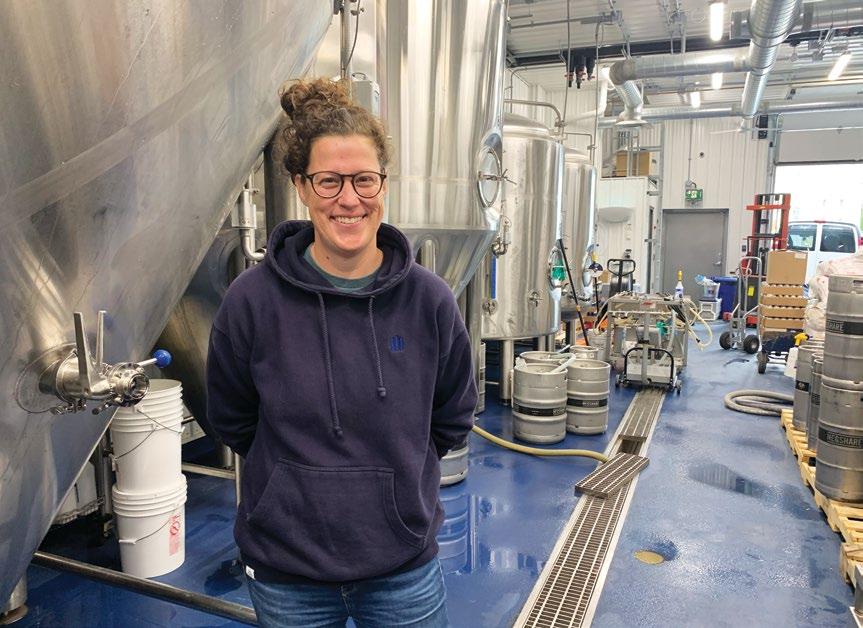
“Our focus is not just women, though. We are talking about marginalised folks in the industry, those that deserve a space and somewhere to feel welcome. We want to remove the barriers that people like Amber and I have experienced in the past.”
And it’s that openness, that accessibility that shines in their beer, too. Wielgosz describes herself as a lager lover while Sarraillon prefers the world of hazy and experimental styles. “We have a great balance when it comes to styles and I think what underpins both of those worlds is our approachability. The strongest ABV of our core beers is 5.8% and the lowest is 4.2%. We know that many people are still new to the world of craft beer so it’s a case of ensuring everyone is welcome.”
And for those that aren’t able to, or don’t want to drink beer, there is the brewery’s growing range of Hop Water. Zero-alcohol, filtered carbonated water blended with hops and loads of fresh fruit. This filtered carbonated water is infused with fruit and steeped with hops that blend to bring fruity, tropical notes and flavours.
“We were first to market with that concept here,” says Wielgosz. “There’s absolutely a segment for that. Having that hop profile and the mouthfeel is something people appreciate. It gives people that option if they want it - and it also goes really well with Gin!”
As the team continue to settle in their new home, they accept there’s almost a bit of catching-up to do, too.
“Purchasing in a residential area, with the equipment going in, I told anyone that would listen that once that kit is in it sure as heck isn’t coming out as it’s inch to ceiling with space!” laughs Wielgosz. “We obviously weren’t able to brew until March, so we’re probably a little behind on inventory compared to where we’d like to be, but we have our growth objectives and plan to hit them. I feel that we’ve accomplished a lot, and I’m proud of where we are.”
She adds: “Regardless of the style of beer you like, or who you are, or what your background is. We want people to feel welcome. At Good Neighbour Brewing, we want to be that bridge to somewhere better.”

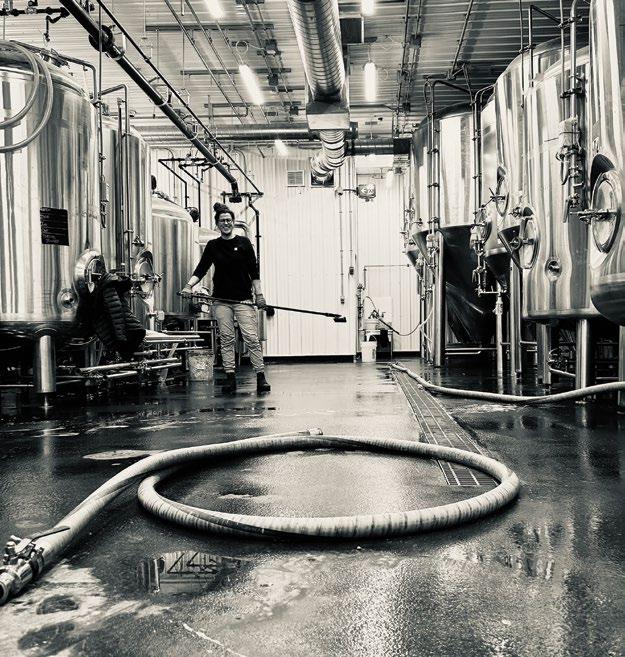
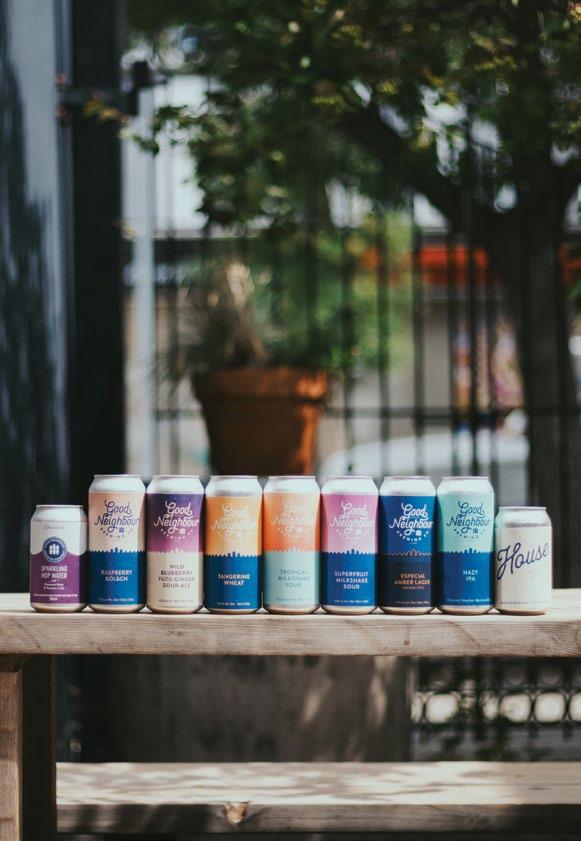





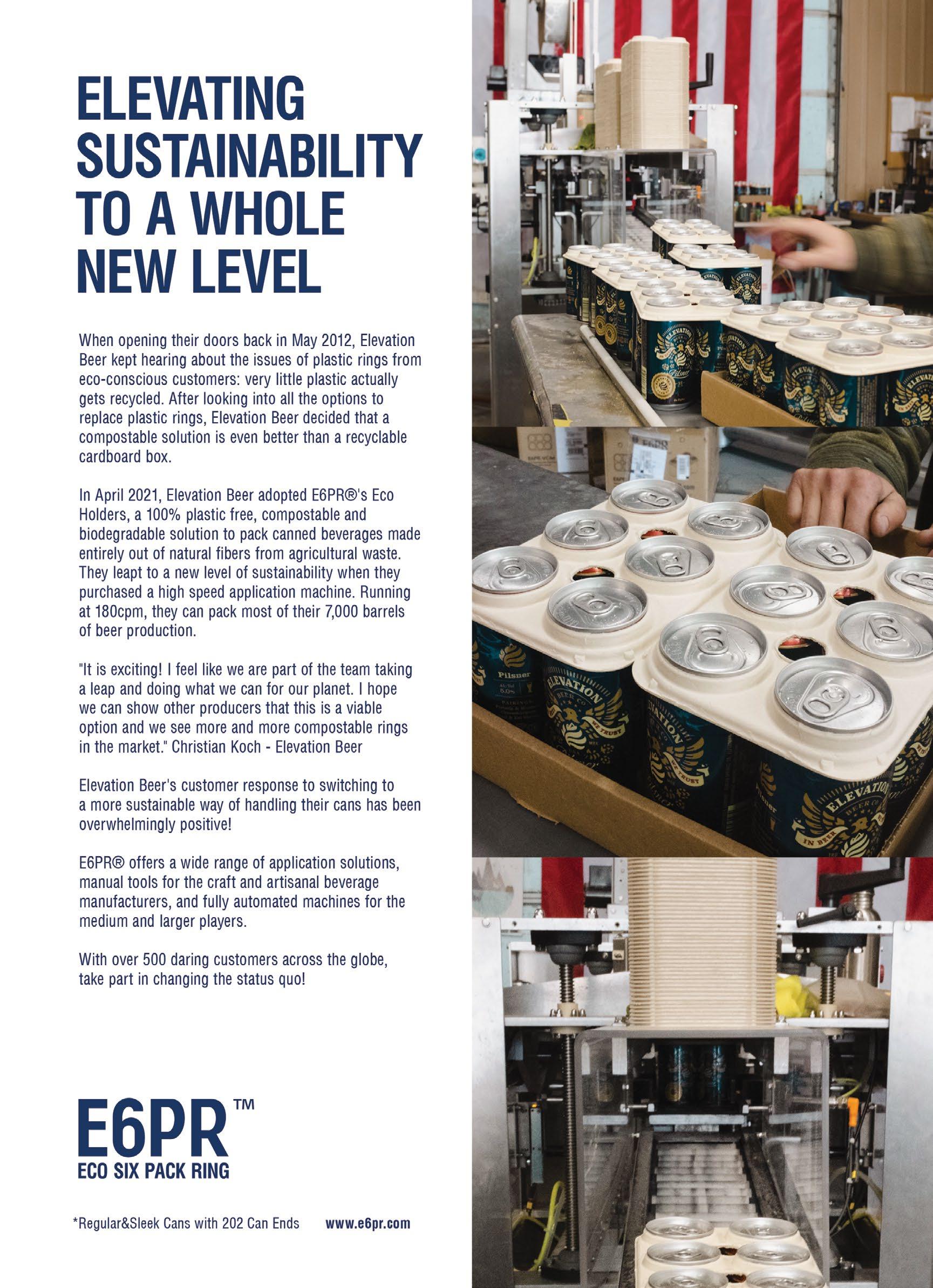

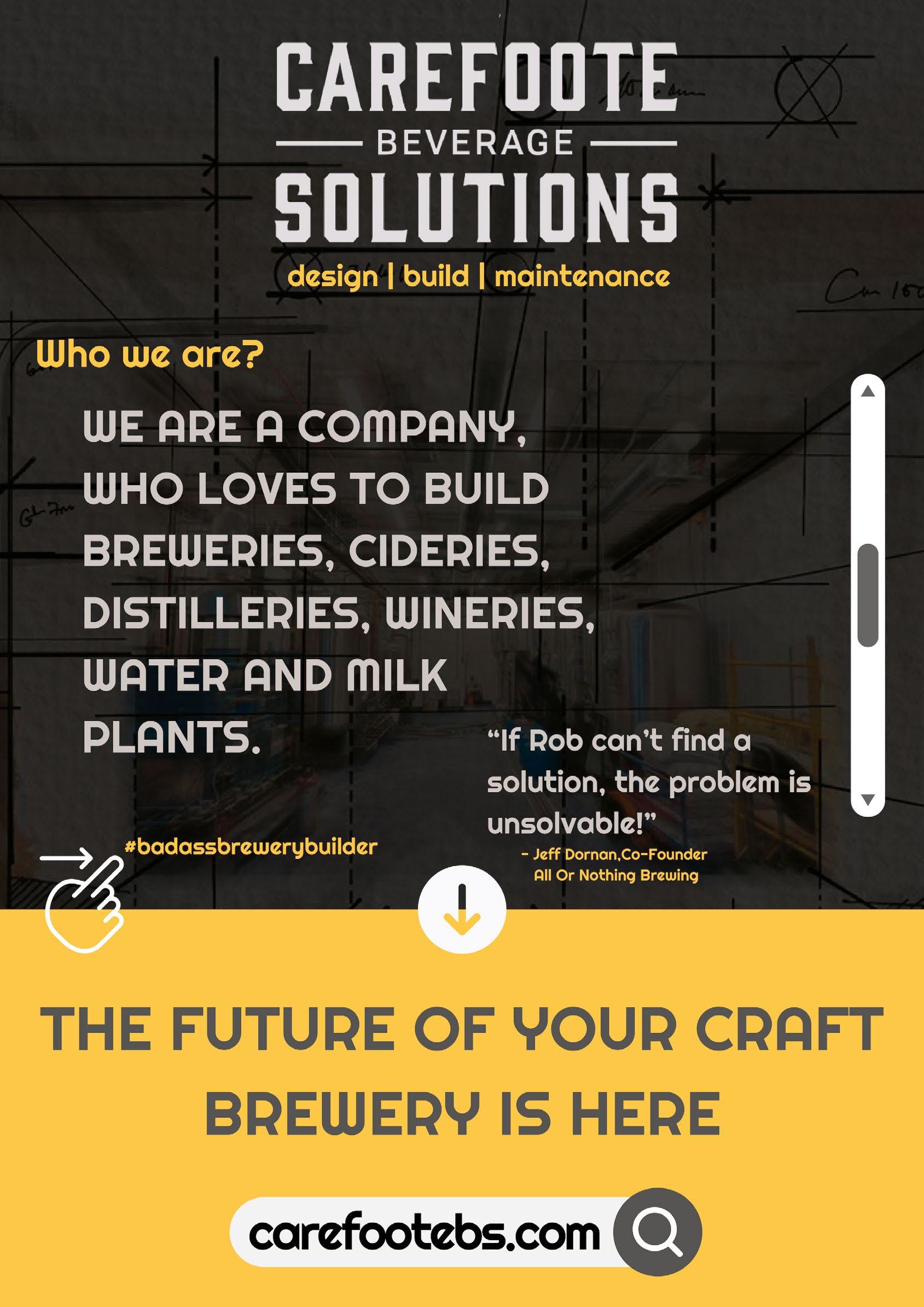
DO YOU TAKE FROM BEING AT EASE, BEING AT HOME?
Nations Community while I was teaching and we wanted to get closer to family as our children got older and were going into schools,” said Hagman. “We knew Manitoulin Island was a beautiful place where you can raise a family and the kids would have access to water activities and outdoor adventures. That’s what drew us here.”
ing Company has made its mark at the Canada Beer Awards with wins in the American Standard Beer Category for all Ontario Craft Beer. They won gold in all of Ontario for their Killarney Cream Ale and silver for the Cup and Saucer English Ale in the English style bitter category right across Canada.
For Manitoulin Brewing Company partner Blair Hagman, it’s all about being home.
His journey has included stops in Belo Horizonte, Brazil and Christchurch, New Zealand. But the former teacher says after basically growing up in Northern Ontario, he was drawn to Manitoulin Island.
“We had our two children up in the Northwest Territories in a remote First
A six-hour drive north of Toronto and nestled in the heart of the Great Lakes, Manitoulin Island is the largest freshwater island in the world. Locally known in Ojibway as ‘Spirit Island’, Manitoulin Island is accessible year-round via the Little Current Swing Bridge and by the MS Chi-Cheemaun, a passenger ferry that operates daily from late May to early October.
Manitoulin Island is also the location of the Wiikwemkoong Unceded Territory, the fifth largest First Nation in Canada in terms of geographical land mass. Wiikwemkoong is home to the people of Three Fires Confederacy: an alliance of the Ojibwa, Odawa and Pottawatomi nations.
Moving to the island is a decision that has reaped dividends. Manitoulin Brew-

Co-owned by Blair Nishin Meawasige and partner Holden Rhodes, Manitoulin Brewing Company strives to create an experience that is as unique as Manitoulin Island itself. Opening its doors in 2015, Manitoulin Brewing now boasts six full time and ten seasonal employees. The patio-silo has a capacity of 68 customers and is a popular draw in the summer season with a great atmosphere and a food truck named The Brewgers. The brew house has a vessel brew system with a capacity of 40 hectolitres and are capable of doing a double brew in a day.
“One of the things that people have noticed about our products is that we stay specific to the style and quality that are the characteristics of what a beer is intended to taste like for each category,” said Hagman. “For our Cup and Saucer
IN THIS PIECE ROD
CHARLES SPEAKS TO MANITOULIN ISLAND BREWING PARTNER BLAIR HAGMAN TO DISCUSS JUST THAT.
English Ale we distinctively looked at what are the typical characteristics of an English Ale. So roasted malts, slight caramel notes, earthy tones and then what are the yeast and the hops and malts that are going to be specific to create that style. We go to great effort not to deviate with it in order to make it our own style or interpretation of what that English Ale could be.”
“That’s what people recognize,” says Hagman. “We get people emailing us to say that we’ve hit the mark on what an English Ale is supposed to be like. And they’re excited to see that they can get this product in Ontario versus trying to get it from England.”
With so many natural landmarks on Manitoulin Island, staying specific to style and quality can be straightforward. When Hagman and his partners started Manitoulin Brewing Company they chose the iconic Little Current Swing Bridge that connects the mainland to the island as art on the Swing Bridge Beer can.
“From there we created Cup and Saucer English Ale, which is named after the most famous hiking trail on Manitoulin. Then we brewed Bridal Veil Pale Ale, named after the waterfall that everybody who visits Manitoulin Island frequents. We’ve just been having fun with that,” says Hagman. “It’s our responsibility to brew high quality products that people can enjoy over and over again. We take pride in this and we’ve received some significant awards and recognition for the quality of beer that we’ve produced, and we’re certainly proud of what we’ve created so far.”
Like most brewers, Hagman is reluctant to name a favourite but says he really loves their Twin Bluffs Vienna Lager because it has depth. It’s amber in color, has roasted malt notes, but is still light, refreshing and can be enjoyed yearround. He says he also gives Endless Summer Pineapple Sour and their popular Killarney Cream Ale high marks.
While brewing beer on the Unceded Territory of Manitoulin Island is a privilege and adventure, there are challenges that come with brewing in Northern Ontario.
One of those challenges is the cost of distribution. The distance away from large urban centres can make it difficult for brewers in rural markets to get their cans onto shelves. Hagman says Manitoulin Brewing has answered the call while maintaining quality standards.
“It costs more to produce the products on Manitoulin and then get it back out to the large market of Southern Ontario,” says Hagman. “We’ve done very well determining the best strategies that minimize our costs and get our product across Ontario. We have our best three beer productsSwing Bridge Blonde Ale, Cup and Saucer and Killarney Cream Ale - in the LCBO in over 350 stores.”
The reception has been very good, with Manitoulin Island Brewing labels showing up across Ontario and in local restaurants. Hagman says for Manitoulin Brewing, the focus will be to just get their beer into the hands of as many people as possible so that it becomes a familiar brand.
“I think that’s the business growth mindset we need to have as a Northern brewery to survive,” says Hagman. “But at the same time, we’d like to see our brewery expand on-site as well with new products and always have something new to offer. It’s exciting to see how many people both locally and across Ontario, and even international travelers that visit Manitoulin Island, enjoy our beer and the stories behind our beer. They provide a lot of great feedback sampling our beer on the patio at the silo.”
That sounds like a plan. Nothing says ‘I’m home’ quite like a cold beer at the Manitoulin Island Brewing silo with a few good friends and beautiful scenery.



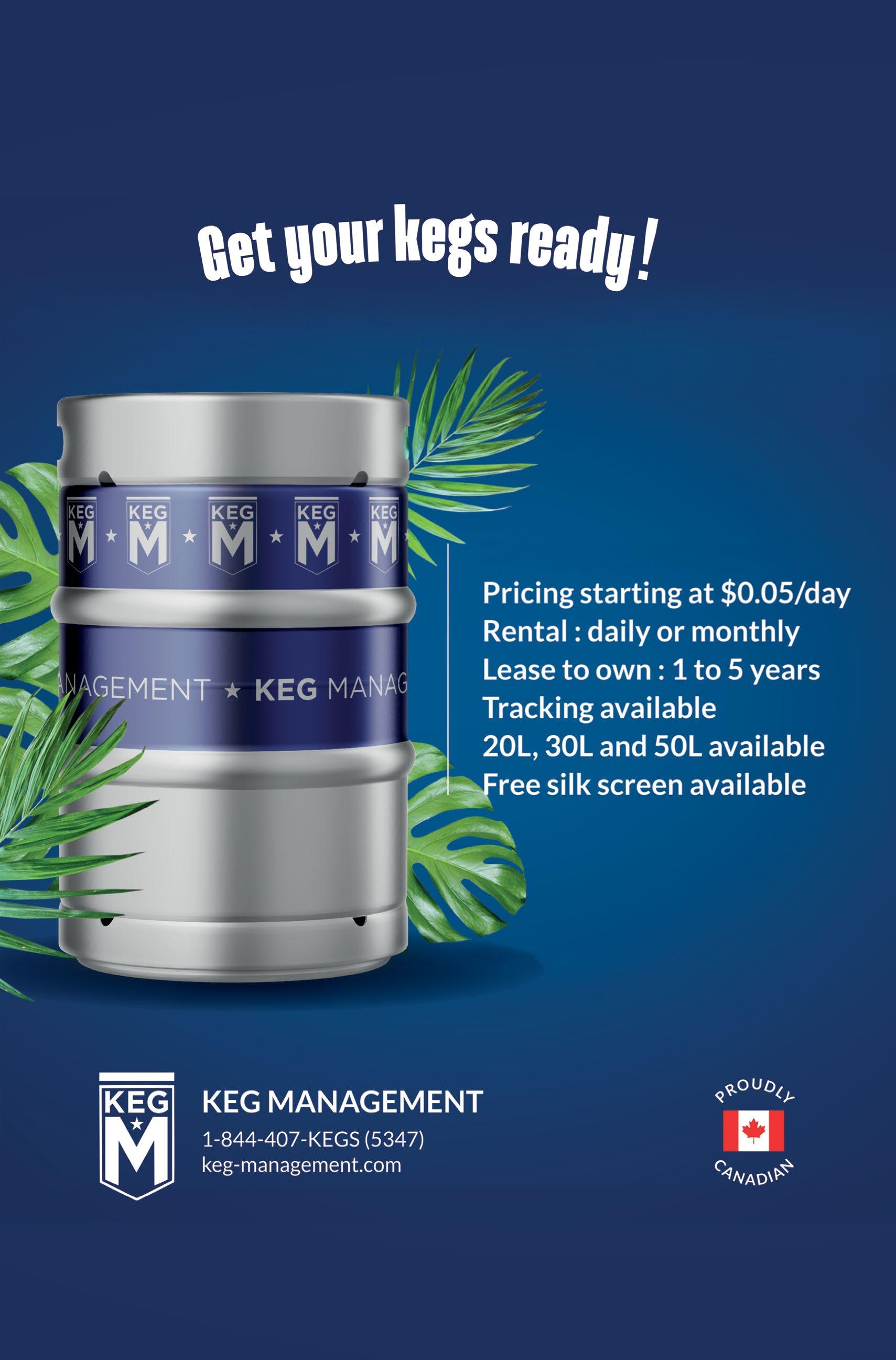
There are several different types of liquid filtration methods that are commonly used in brewing processes, each of which offers a unique set of advantages and disadvantages.
The most common style of filter is depth filtration: This type of filtration is often used to capture and prevent larger particles and suspended solids, such as Diatomaceous Earth (DE), from entering the Bright Tank.
Carbon filtration: This method uses activated carbon to remove impurities and improve flavor. It is commonly used for removing chlorine or organic compounds and is effective for treating large volumes of liquid.
Since the early 1970’s, ultrafilter has been providing the food and beverage industry with best in class, validated sterile air, clean steam, and liquid filtration products. From the beginning of the brewing process, through to the finished product and packaging, ultrafilter has you covered to ensure ultimate consistency, and purity to deliver the highest quality product possible.
Let’s begin with Liquid Filtration. An essential step in the brewing process, as it helps to remove unwanted particles from the beer and ensure that it is clear and visually appealing to consumers. Suspended solids, such as yeast, grains, and other contaminants, can negatively affect the overall taste and appearance of the beer. ultrafilters range of cartridges and housings provide solutions for any brewing application.
Filtration is also important for maintaining consistency in the brewing process. By utilizing filtration, brewers can ensure that their beer meets a specific, and consistent standard every time it is produced. This is crucial for large-scale operations and for beer brands that are looking to establish a consistent taste and quality across their portfolio.
Utilizing the correct type and grade of filtration can also help to extend the shelf life of beer by removing impurities that can lead to spoilage or undesirable flavors. This not only ensures that consumers are receiving a high-quality product, but it also reduces the likelihood of returns or spoilage-related losses for the brewery.
Surface filtration: In this type of filtration, the liquid is passed over a filter membrane, which traps particles on its surface. It is effective for removing smaller particles but can be costly and may require additional processing steps to remove trapped particles from the membrane.
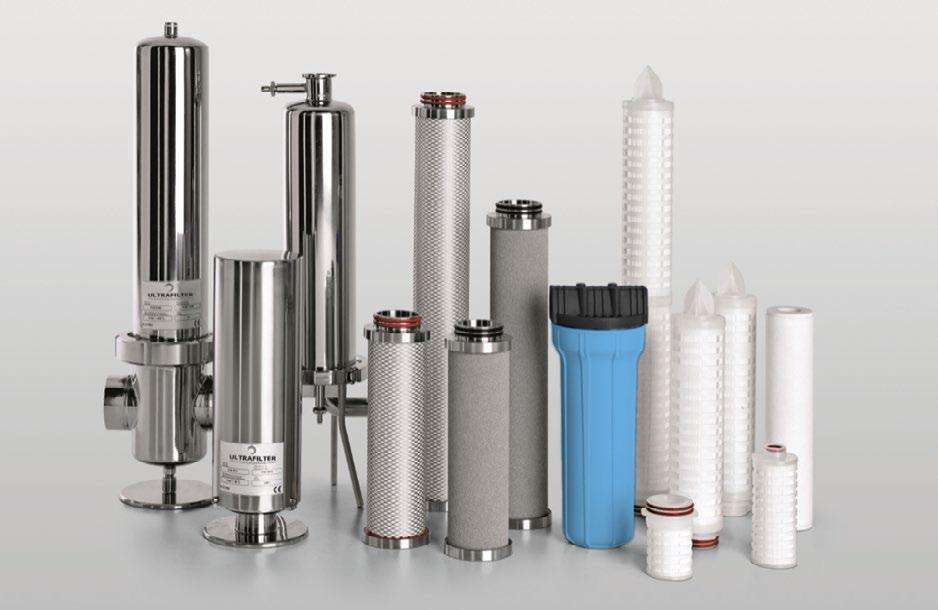
Centrifugal filtration: This method uses centrifugal force to separate solids from liquids. It is effective for removing heavy particles but may not be as effective for very fine particulates.
Crossflow filtration: This technique uses a filter media that allows the liquid to pass through, while particles are trapped and removed from the system. It is effective for removing particles of all sizes and can be used over longer periods of time than other methods.
Overall, the choice of filtration method will depend on the specific needs of the brewery and the goals of the brewing process. Our team offer no charge discovery calls to assess what will suit your brewery the best. From our experience, the biggest liquid filtration challenges facing a master brewer today are related to process efficiency, consistency, and quality control. Here are some of the specific challenges that our brewers face. How do these compare to your own challenges?
Efficiency: Liquid filtration can be a time and resource-intensive process that slows down the overall brewing process. Brewers need to strike a balance between the speed of filtration and the effectiveness of the purification process. Solutions to improve filtration efficiency include optimizing conditions, streamlining filtration protocols, and using the right type and size of filter technology for specific application(s).
Consistency: We often receive feedback from brewers stating that they struggle to ensure that the quality and taste profile of the beer remains con-
WHEN BREWING, THERE ARE ARGUABLY TWO KEY COMPONENTS THAT MAKE ALL THE DIFFERENCE. THE BEST INGREDIENTS, AND THE CORRECT FILTRATION.
sistent from batch to batch. Filtration is an important part of this consistency process, but at the same time we need to be cognisant that filtration does not inadvertently alter the flavor and aroma of the beer.
Quality control: Another challenge is ensuring that the beer is free from contaminants, such as bacteria and yeast, as these can negatively impact the quality of the finished product. Brewers need to have robust quality control programs in place to ensure that filtration is removing unwanted particles and that the final product meets their quality specifications on a consistent basis. With ultrafilters validated, and DOP tested range of cartridges, we ensure and guarantee a repeatable, measured consistency of performance.
Cost: Filtration can be an expensive consumable for breweries, especially if they are processing large volumes of liquid. A balance between the benefits of filtration and the cost of the setup and operation of the purification process are essential. Some filtration methods, such as depth filtration, can be carried out with relatively low capital and operating costs, while other methods, such as carbon filtration, require significant capital investment. The ultrafilter team consult with you to ensure that the housings and cartridges are correctly sized, while selecting satisfactory micron ratings. Factory direct pricing enables us to drive your filtration costs down, while always retaining filtration integrity and efficiency.
Lead time challenges: These are a major issue for brewers when it comes to liquid filter cartridges. Common ones include:
Limited availability: Some filter cartridge types may only be available from a few suppliers, and those suppliers may have limited stock of the filter cartridges. This can lead to longer lead times, especially if the cartridges need to be shipped from overseas or made to order.
Unpredictable demand and consumption: Brewers may experience sudden spikes in demand for their beer, which can put a strain on their production and subsequently the filtration supply chain. If they do not have enough filter cartridges on hand to meet demand, they may experience production downtime or delays.
• Customization needs: Some brewers may require custom filter car-
tridge designs to meet their specific filtration needs. This can increase lead times, as the cartridges may need to be manufactured to order.

• Shipping delays: Transportation delays became the # 1 complaint during the recent pandemic. In addition, moving products can be affected by weather conditions, labour strikes, transportation, and logistical issues. At ultrafilter we have invested in a “Double Order Program”, whereby we process exactly what you order and then duplicate the quantities for inventory purposes. This results in the cartridges you consume being in stock the next time you need them. Ultraplanning is a Value Added Program we offer to assist you in overcoming supply chain challenges.
The ultraplanning process begins with ultrafilter performing a no charge discovery call to identify the filtration you are currently using. We list each housing, its point of use and the cartridge or element details associated to each one.
Next, we survey the stores area, or inventory crib, to take stock of the on-site filter inventory.
Together we discuss and agree on min/ max levels, and our objective is to guarantee zero outages
Note: We often identify duplicated inventory, where person X purchased part # 1234, and person Y used a different supplier to purchase a similar product but with a different nomenclature/part #. Everything is catalogued to ensure that we achieve:
A consistent and reliable supply chain of filter cartridges, from a single source.


Forecasted demand, with recommended change out dates. Replacement filters can be ordered, and delivered well in advance to ensure an adequate supply is always maintained and available.
Optimized cartridge usage and onsite inventory, to eliminate inventory duplicates,and reduce the need for unnecessary replacements. This will also negate against lead time delays.
Explore and consider alternative filtration methods, to lower filtration costs and multiple inventory filter types and styles.
Fixed pricing, over a term to be agreed upon, so as price increases and market volatility don’t affect the agreed ultraplanning program prices.
CFIA and other industry related audits are a breeze when it comes to demonstrating filter change out times, dates, and completion, as ultraplanning documents everything, within the program.
Sterile compressed air is an important input in the brewing process as it ensures the elimination of contaminants, such as bacteria and mold, which can negatively impact the quality of the beer. The use of sterile compressed air is critical for maintaining consistency and reliability in the brewing process. Here are some of the ways that sterile compressed air is used in brewing:
Carbonation: Compressed air is used for carbonation of beer and other beverages. Sterilized compressed air is used to force carbon dioxide into the beer in order to give it the characteristic effervescence and head.

Fermentation: Sterile compressed air is used during the fermentation process to introduce oxygen and circulate the wort. This helps to encourage the growth of healthy yeast and other microorganisms, which play a critical role in the fermentation process.
Bottling and kegging: Sterile compressed air is used during the bottling and kegging process to ensure that no contaminants, such as bacteria or fungi, are introduced into the beer. This helps to ensure that the beer maintains its integrity and flavor profile, which is critical for maintaining customer satisfaction.
To ensure that compressed air is sterile, brewers use ultrafilters P-SRF range of 0.2μ, steam sterilizable filters. The P-SRF should be protected by pre filters to remove contaminants such as moisture, oil, and dust. The P-SRF can be steam sterilized 100 times, guaranteed, or autoclaved.
Brewery bottle washing involves a cleaning process that typically uses a combination of mechanical and chemical methods to remove impurities and contaminants from bottles prior to filling them with beer. One common method of filtration used in brewery bottle washing is a multi-stage filtration process that includes the following steps:
Pre-filtration: The first stage involves coarse pre-filtration to remove large particles and debris such as labels and bottle caps. This step is crucial to protect downstream filtration stages from clogging.
Carbon filtration: The next stage involves carbon filtration to remove organic matter and other impurities, such as odors, that could affect the flavor and aroma of the beer.
Fine filtration: This final stage involves fine filtration, where a filter cartridge with smaller micron pore sizes is used to capture any remaining particles and bacteria that could be harmful to the beer.
Overall, the combination of these different types of filtration is effective at providing a thorough cleaning process that removes impurities and ensures that the bottles are clean and ready for beer filling. Each brewery may use slightly different approaches to bottle cleaning depending on their specific needs and preferences.
BREWERY FILTRATION APPLICATIONS:






Sterilizing in Place (SIP Skid)
To avoid contamination, equipment downtime and ensure process safety it is critical to filter steam. Ultrafilters P-EG housing and our P-SWM 25 and 5 micron steam elements ensure purified steam for your SIP system.
Boiler Feed Water
Only with clean water can brewers produce and ensure purified steam, therefore it is prudent to filter the boiler feed water. Feed water consists of returned condensate and fresh make-up water. Contamination in this water can be introduced into the steam system and compromise the boiler efficiency. ultrafilter PF-EG housings and P-SM filter elements are designed to handle the high temperatures and solids associated with feed water filtration.
Steam Heated Mash and Lauter Tun
When producing beer, a produc-


tion step known as mash out separates the mash into a clear liquid Wort. The first step of the process is referred to as mash out in which the mash is heated to a temperature of 171°F, (77 C°). This is achieved through direct steam contact or with a Lauter Tun. To ensure that the heat transfer equipment is operating effectively and reliably, it is essential to filter the steam. ultrafilter P-EG housings and P-SWM, and P-GS 5 micron filter elements remove contaminants that could reduce heating efficiencies over time.
Yeast Propagation Systems and Wort Aeration
To start the fermentation process, breweries utilize Wort Aeration and Yeast Propagation systems which require Sterile air and oxygen to kick start the fermentation process. Steam is used to sterilize the equipment between production batches. Using ultrafilter’s Culinary Steam and Sterile Air Filtration ensures that yeast growth is done effectively and consistently each time.
Product Push Out
In some productions CO2 may be used to push out the product and clean processing lines. ultrafilter’s P-EG housing and P-SRF filter element ensures that the CO2 is sterile and will not contaminate the finished beer or equipment.
Counterbalance Filter
Counterbalancing is used as an alternative to tank ventilation. ultrafilter’s P-EG housing and P-BE sterile air filter, placed in the balance line, will prevent cross-contamination.

In-line
When carbonating beer venturi pipe aeration systems are utilized. To ensure that quality standards are maintained, it is essential that all CO2 gas is filtered. ultrafilter’s P-EG housing and P-SRF filter element ensures that the CO2 is sterile and will not contaminate the finished beer or equipment.
During Beer production Diatomaceous Earth is utilised to turn the beer into a clear substance. The DE must be filtered with a blank filter. To ensure a bright and clear product, the Trub must be filtered out. For both filtration steps, ultrafilter’s PP100 & PP elements with our sanitary PF-EG filter housings are a recommended filter combination.
during the filling process is free of any microbiological contamination. ultrafilter’s filtration helps support the integrity of these processes and to produce a consistent quality product. Clean steam is a vital component for many brewing processes as it is used to sterilize equipment and provide sanitary conditions for the brewing process. Filtration plays an important role in ensuring that the clean steam is free from impurities that could affect the quality and safety of the final product.
Here are some of the reasons why clean steam filtration is important in brewing:

Quality control: Impurities can negatively impact the taste, aroma, and overall quality of the beer. Filtration of the clean steam can remove contaminants such as particulates and microorganisms, ensuring that the steam is sterile and free from impurities that could negatively im -
pact the quality and safety of the final product.
Safety: The presence of certain impurities such as bacteria and viruses can be a safety hazard, causing infections or illnesses. Filtration of the clean steam helps to ensure the safety of the brewing process by eliminating these hazardous microorganisms.
Equipment protection: Impurities in the steam can accumulate in the system and cause scale build-up, corrosion, or fouling, which can damage the equipment or cause inefficiencies. Filtration can remove these impurities and protect the system from these potential problems.
Compliance: In the brewing industry, there are strict regulations and standards for the quality of the beer. Filtration of clean steam helps brewers to meet these compliance requirements, ensuring that their beer is safe and of high quality.
Overall, clean steam filtration is an essential step in ensuring the safety, quality, and consistency of the brewing process. It helps brewers to maintain high standards of quality and safety, control costs, and improve the efficiency of their operations.
The rinse water used in the cleaning and sterilising of Kegs must be filtered to ensure contaminant free storage of the finished product. Filtration at this step is critical and serves to protect customer investment. ultrafilter’s PFEG housing and PP100 filter element can provide the necessary point of use filtration.
Ultrafilter’s PF-PES filter range removes beer spoiling microorganisms and ensures a long shelf life. ultrafilter’s P-EG housing and sterile gas filter is used to clean bottles and purge oxygen before filling. The sterile air filter P-SRF ensures that the counter pressure gas used

